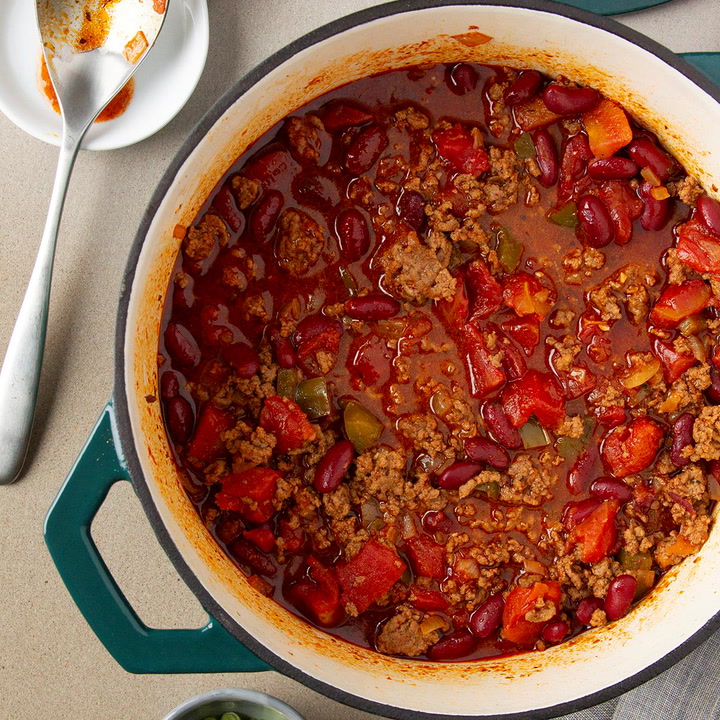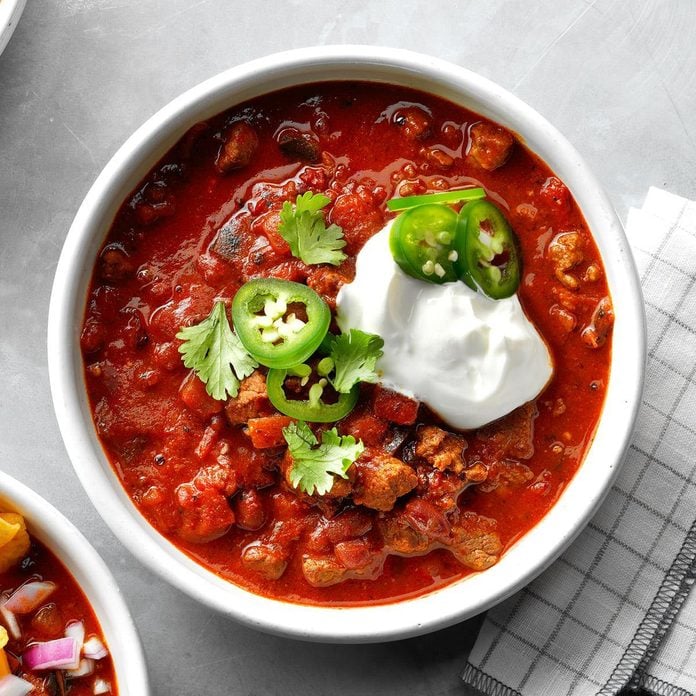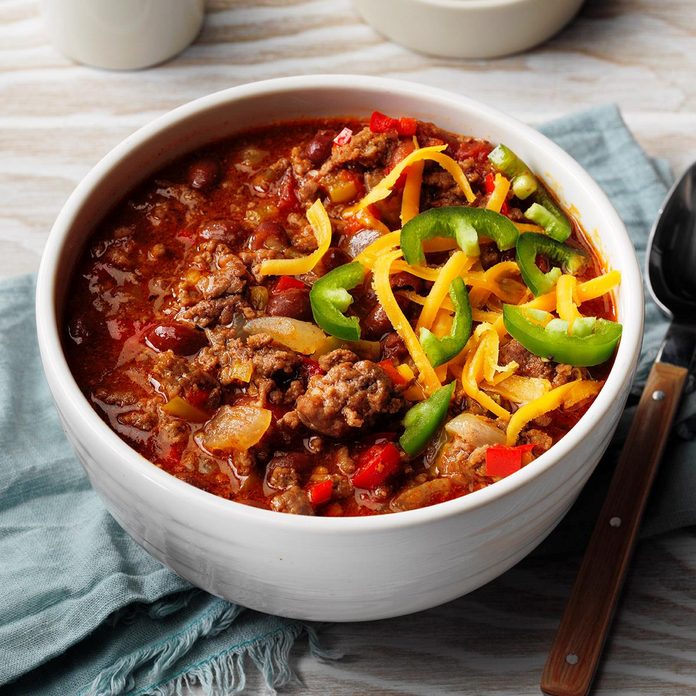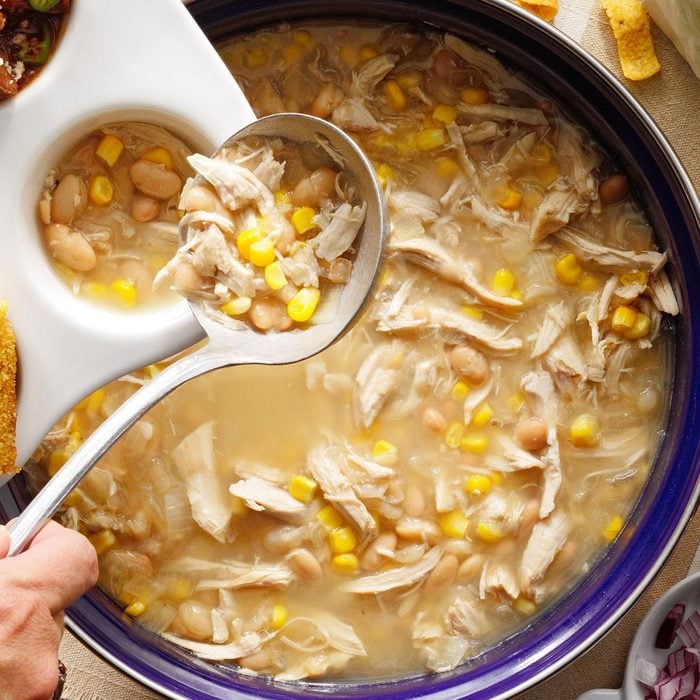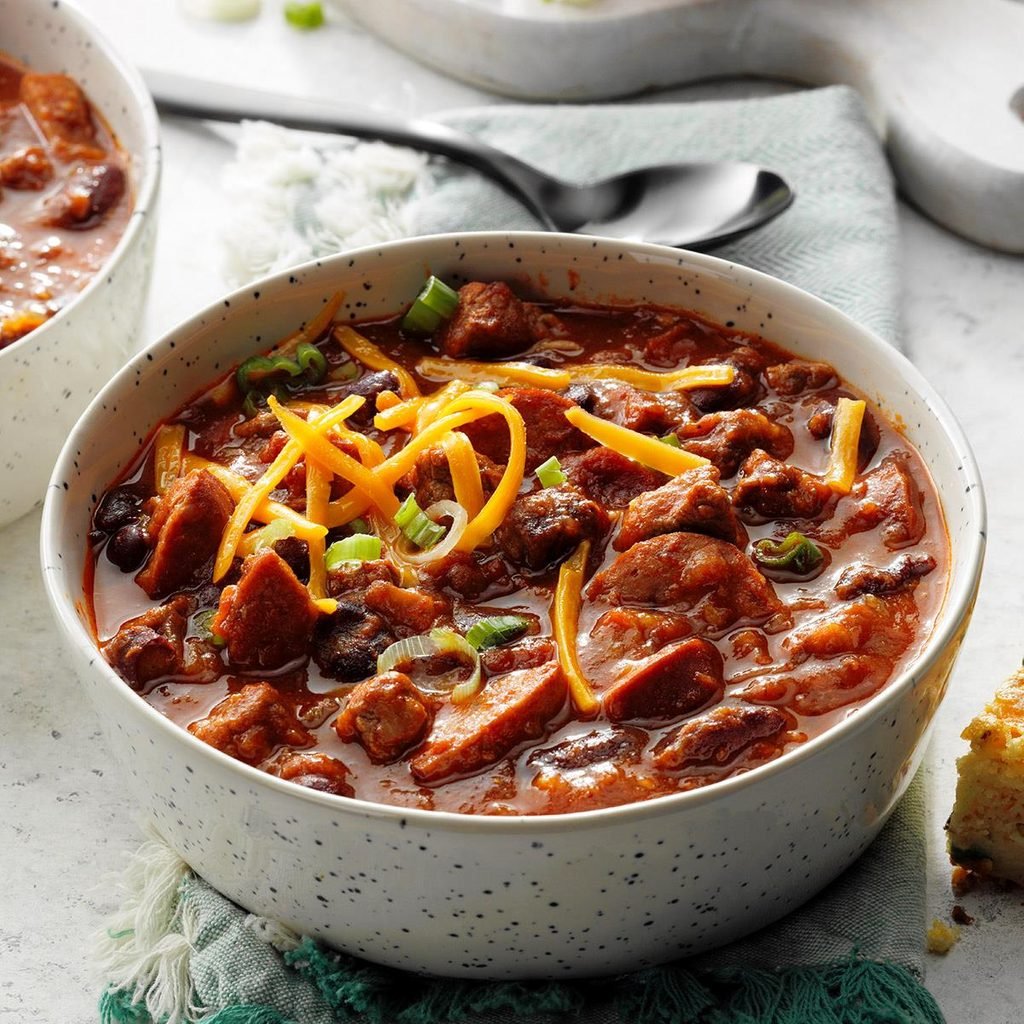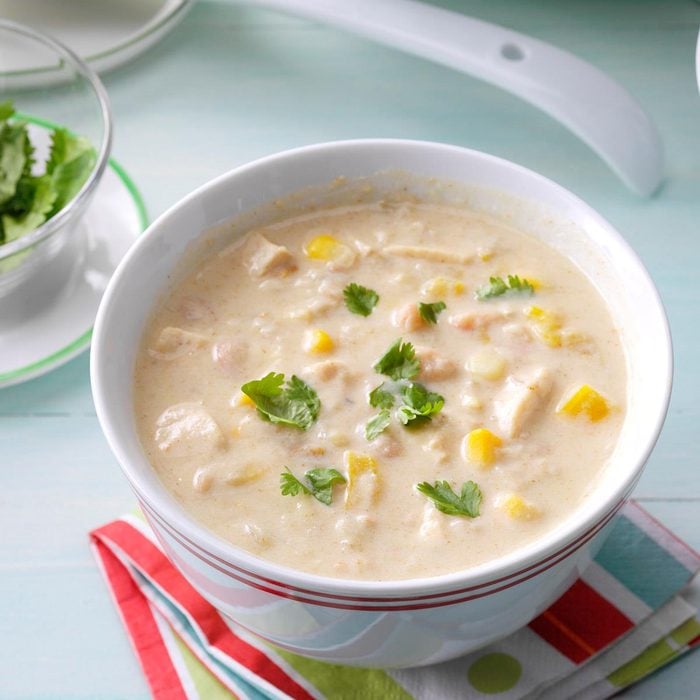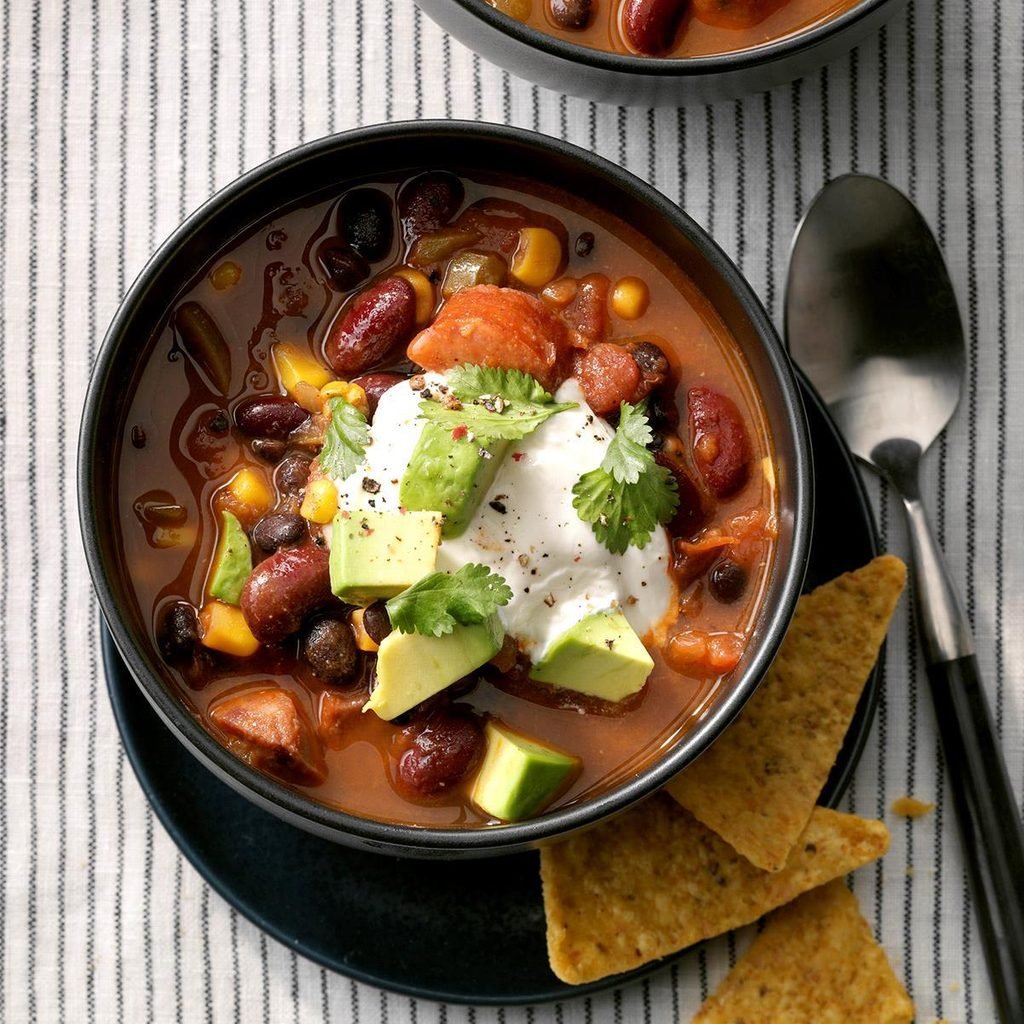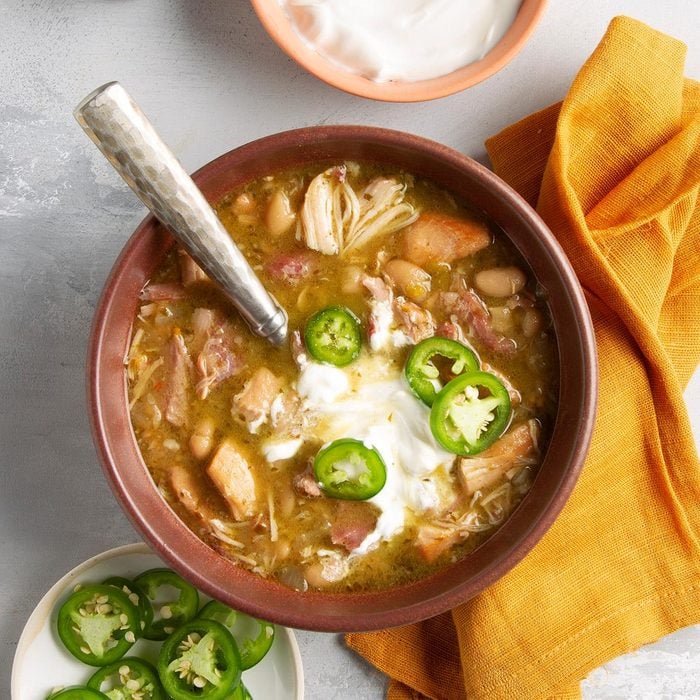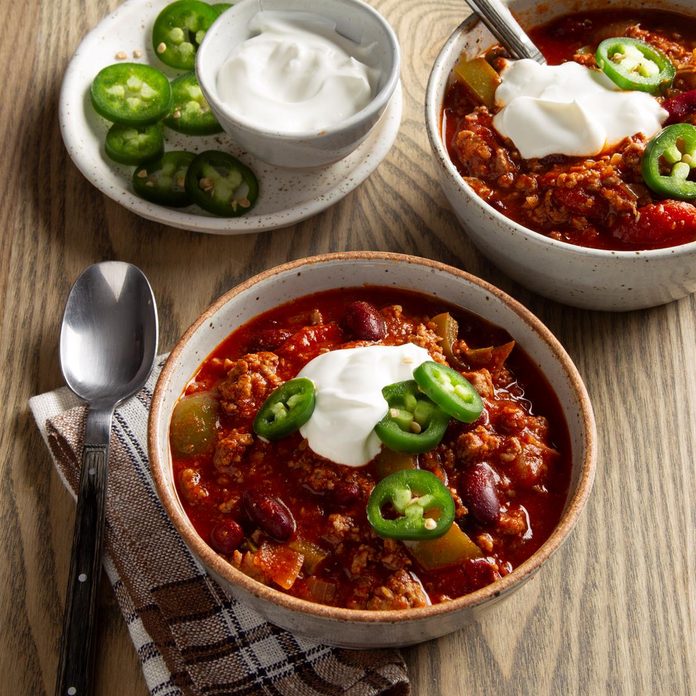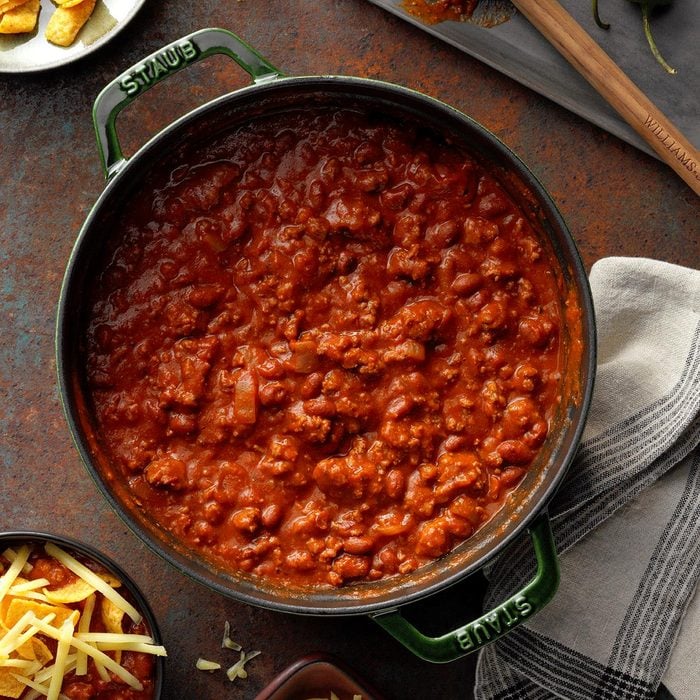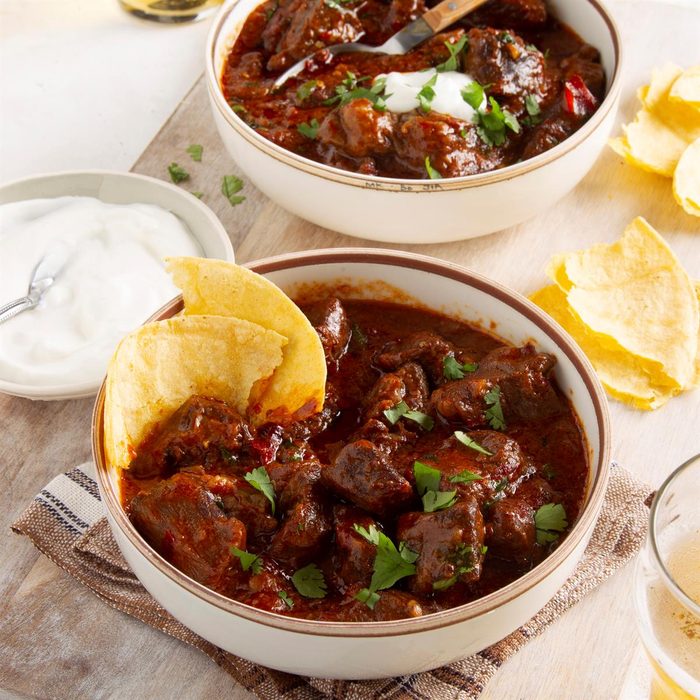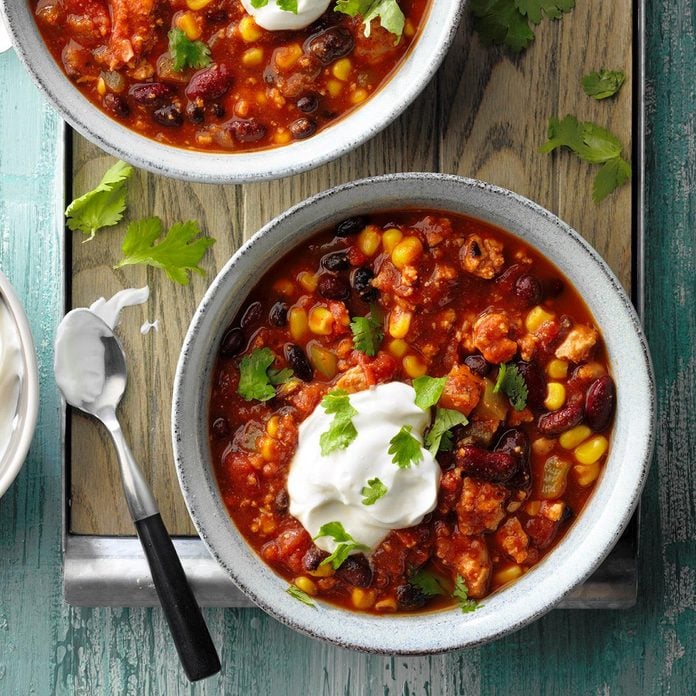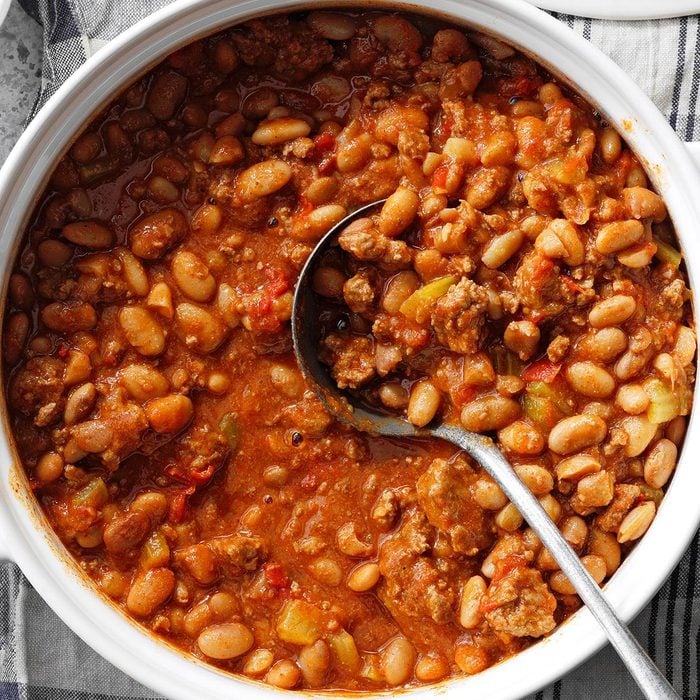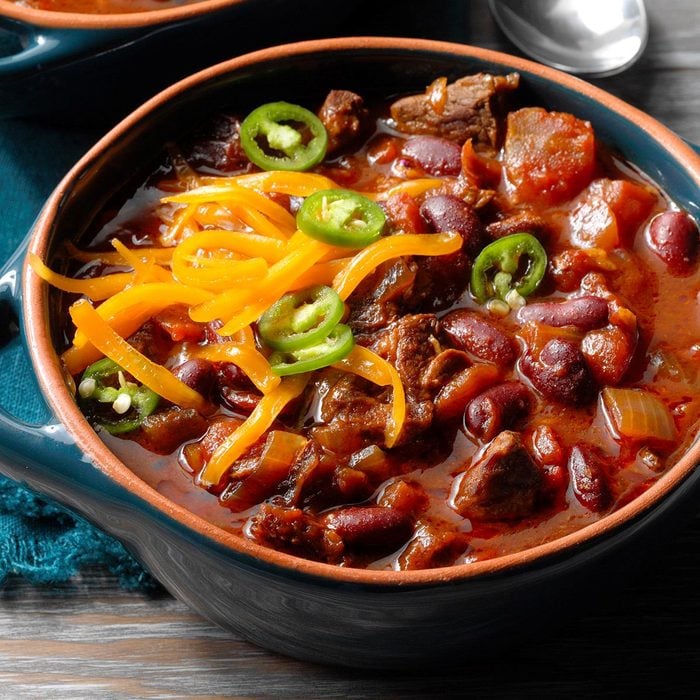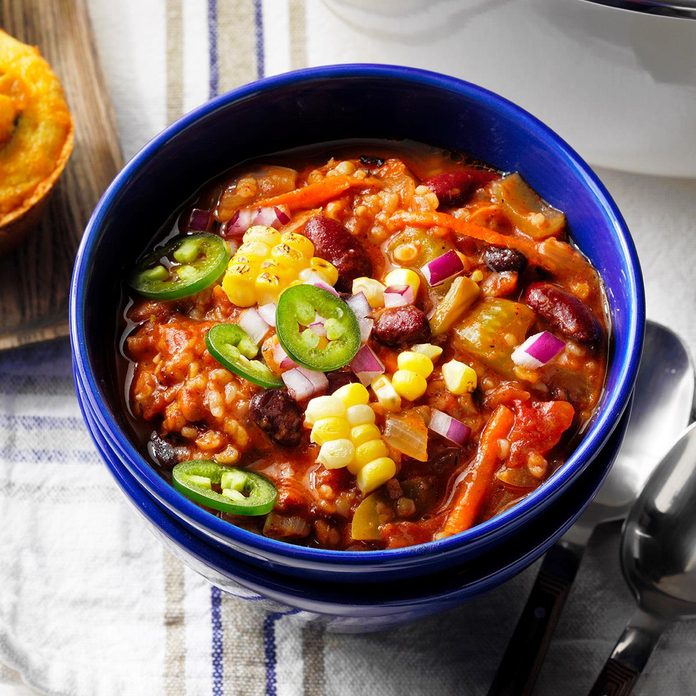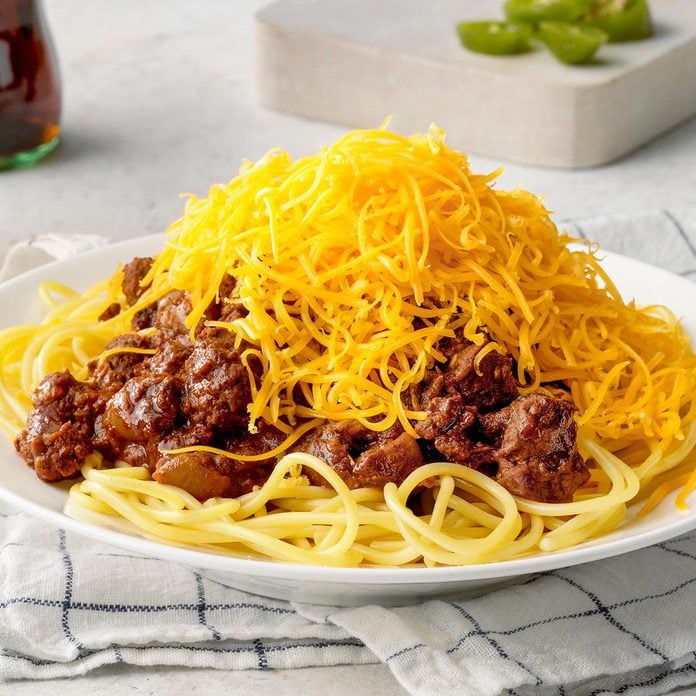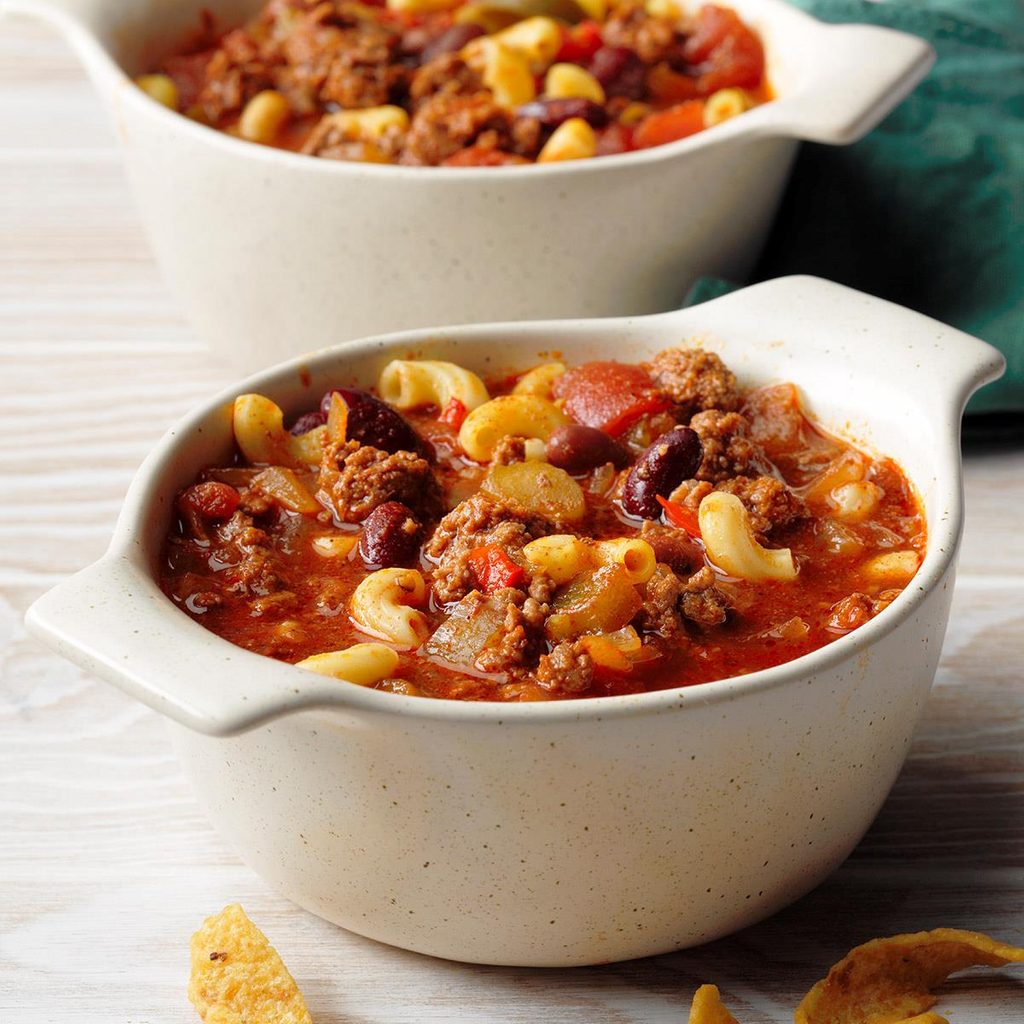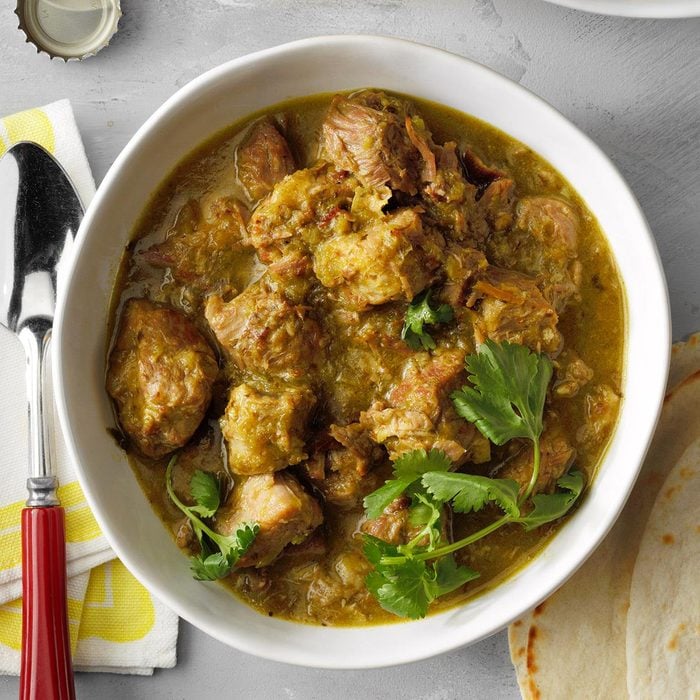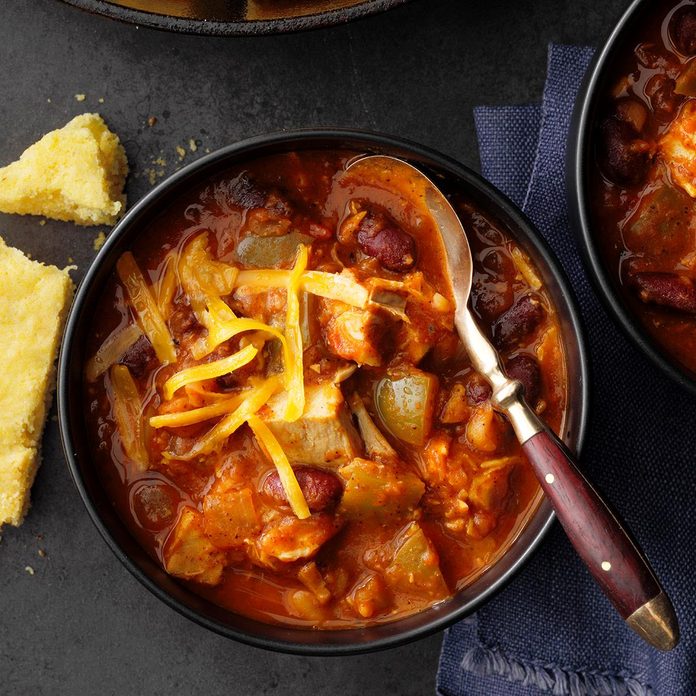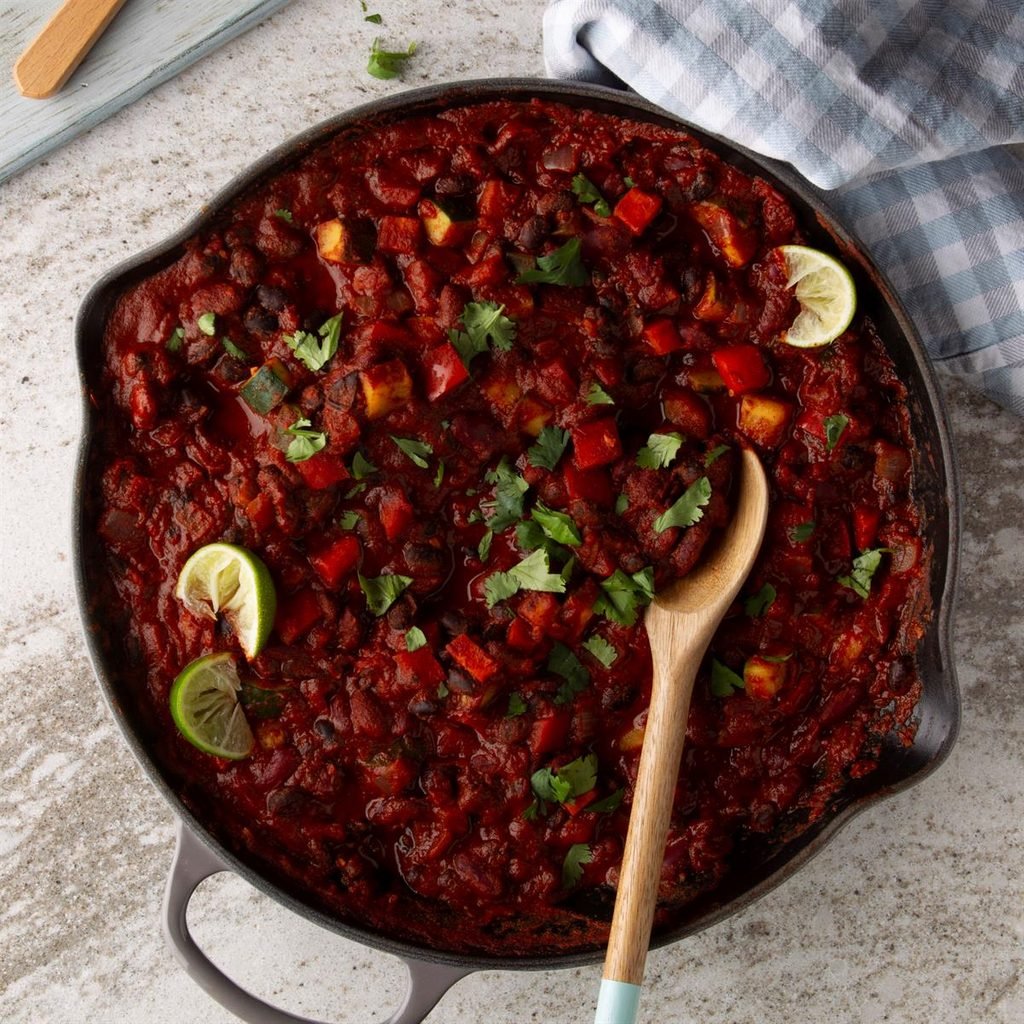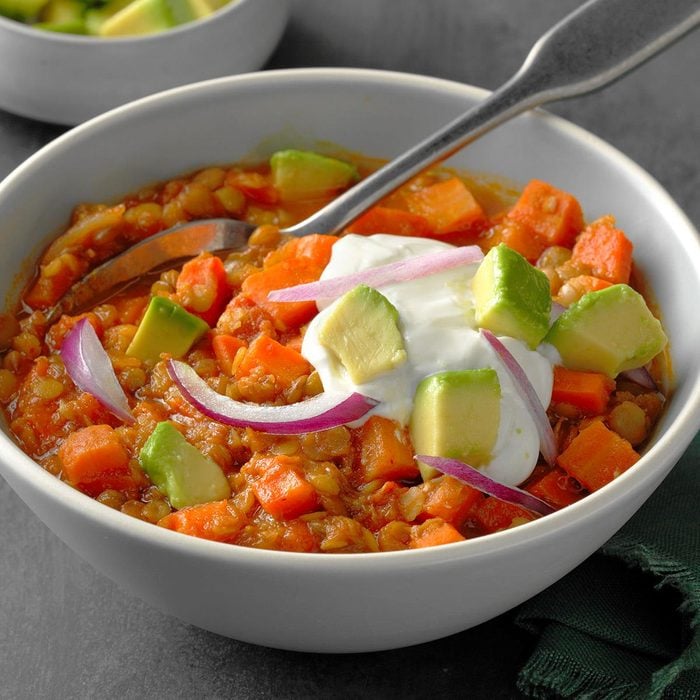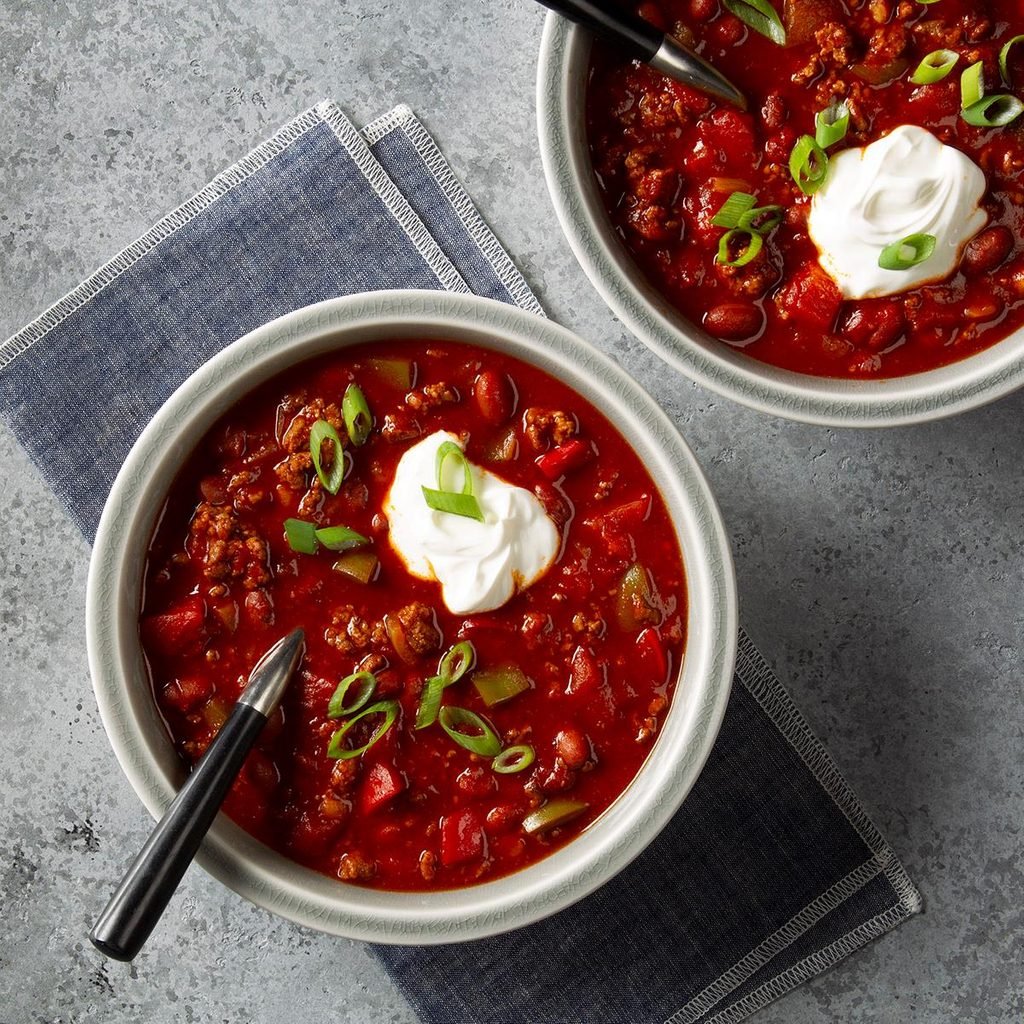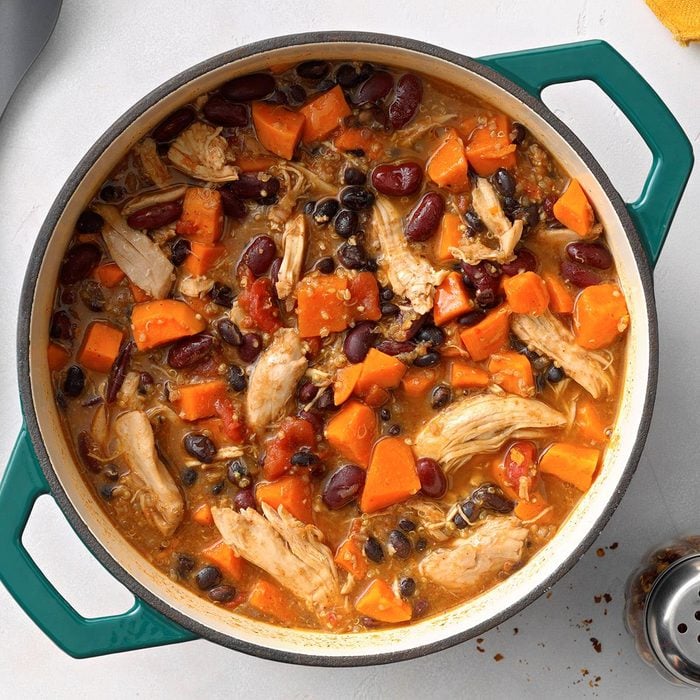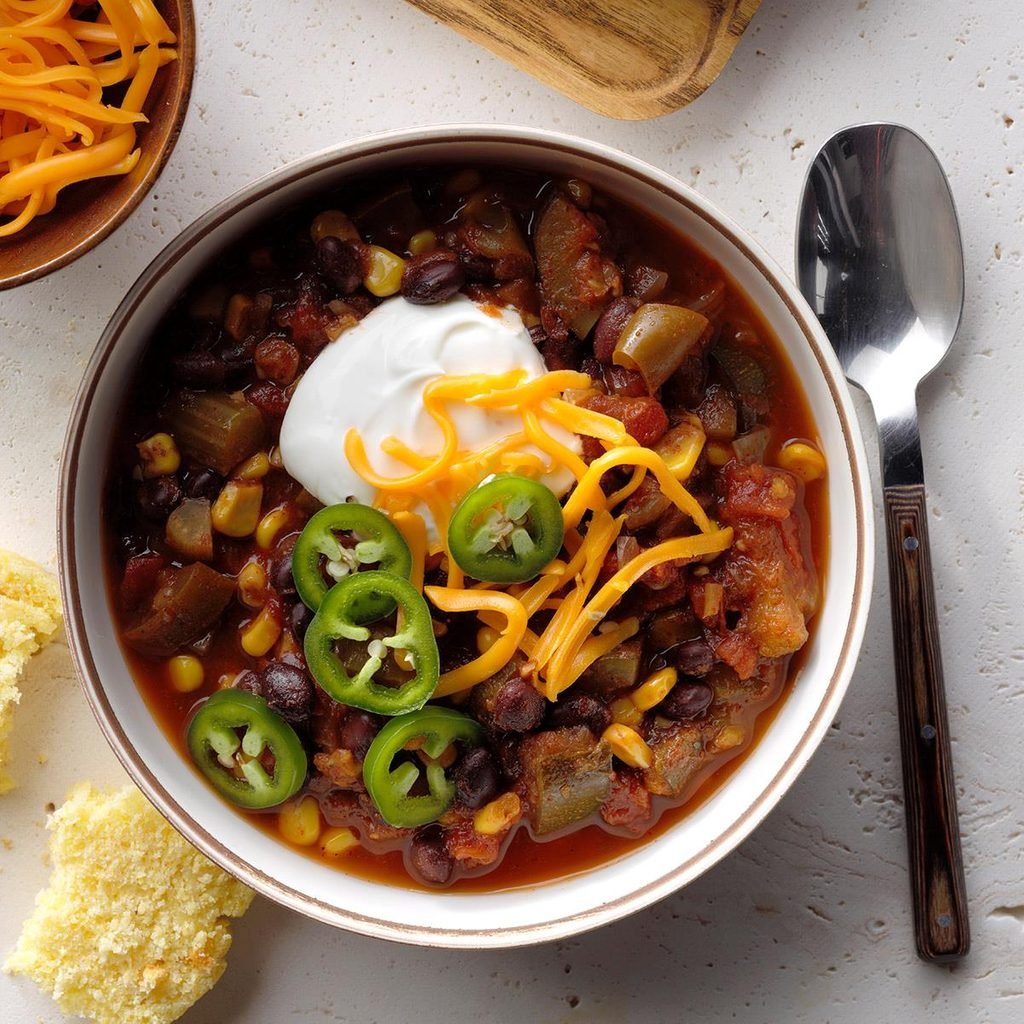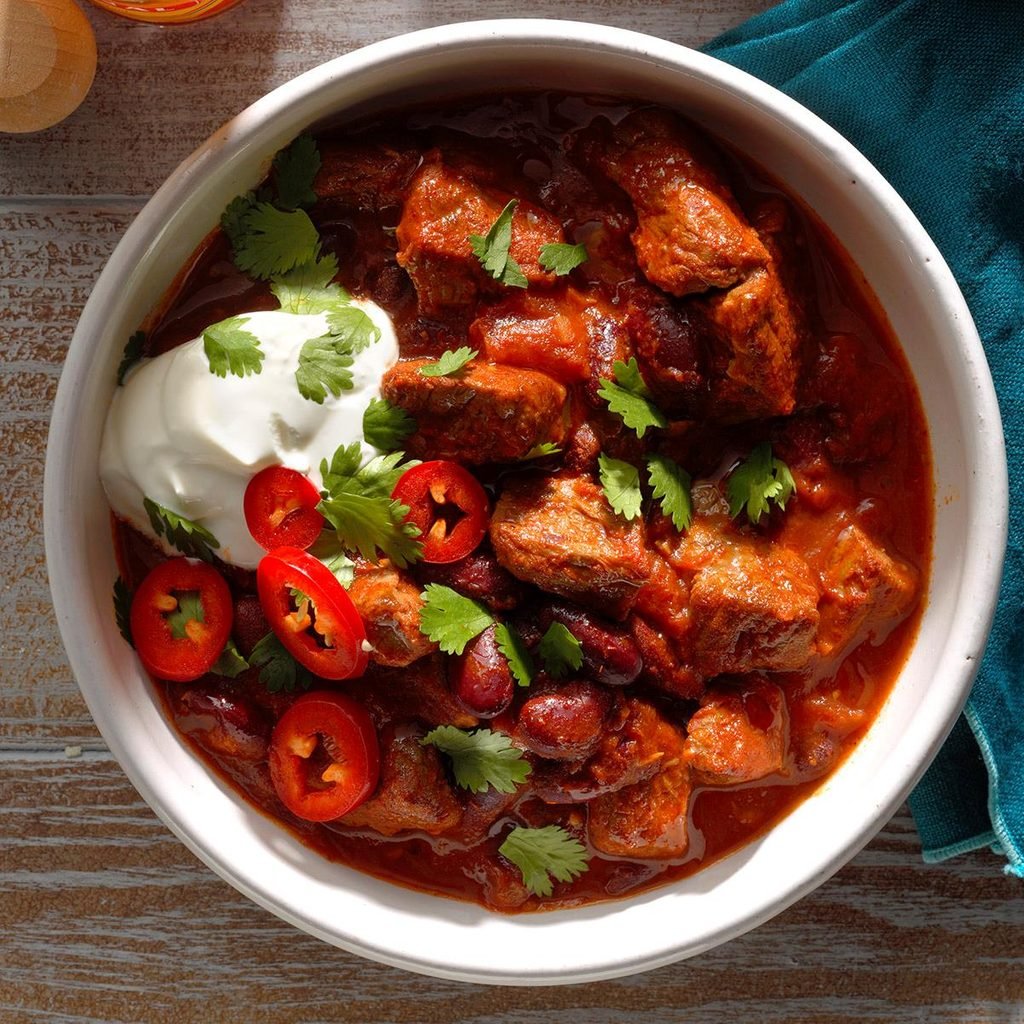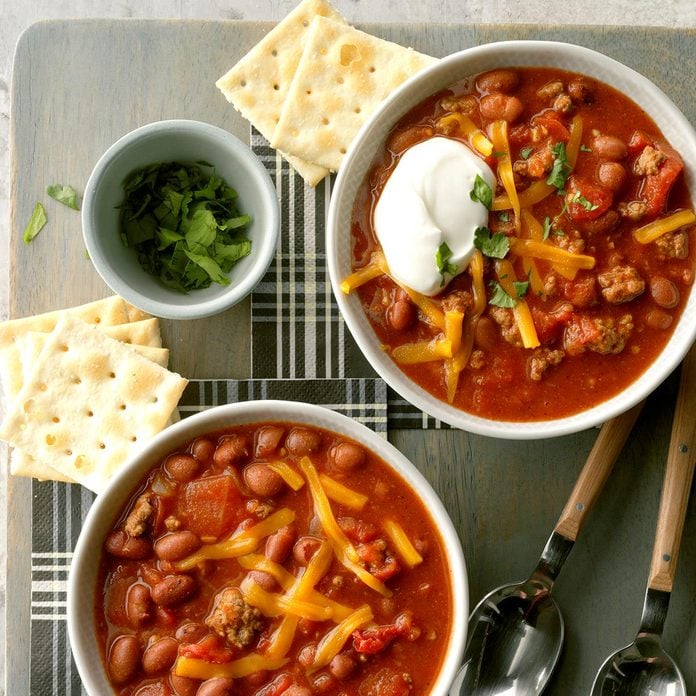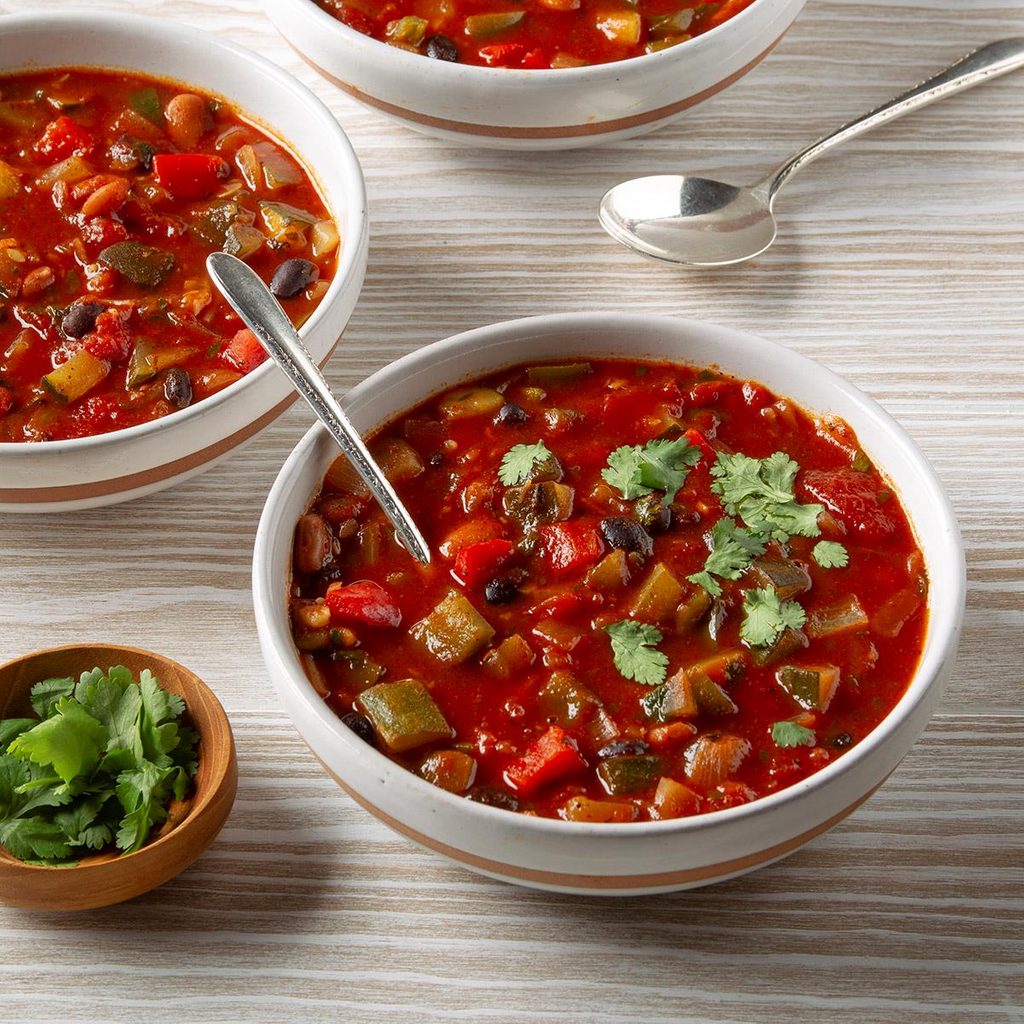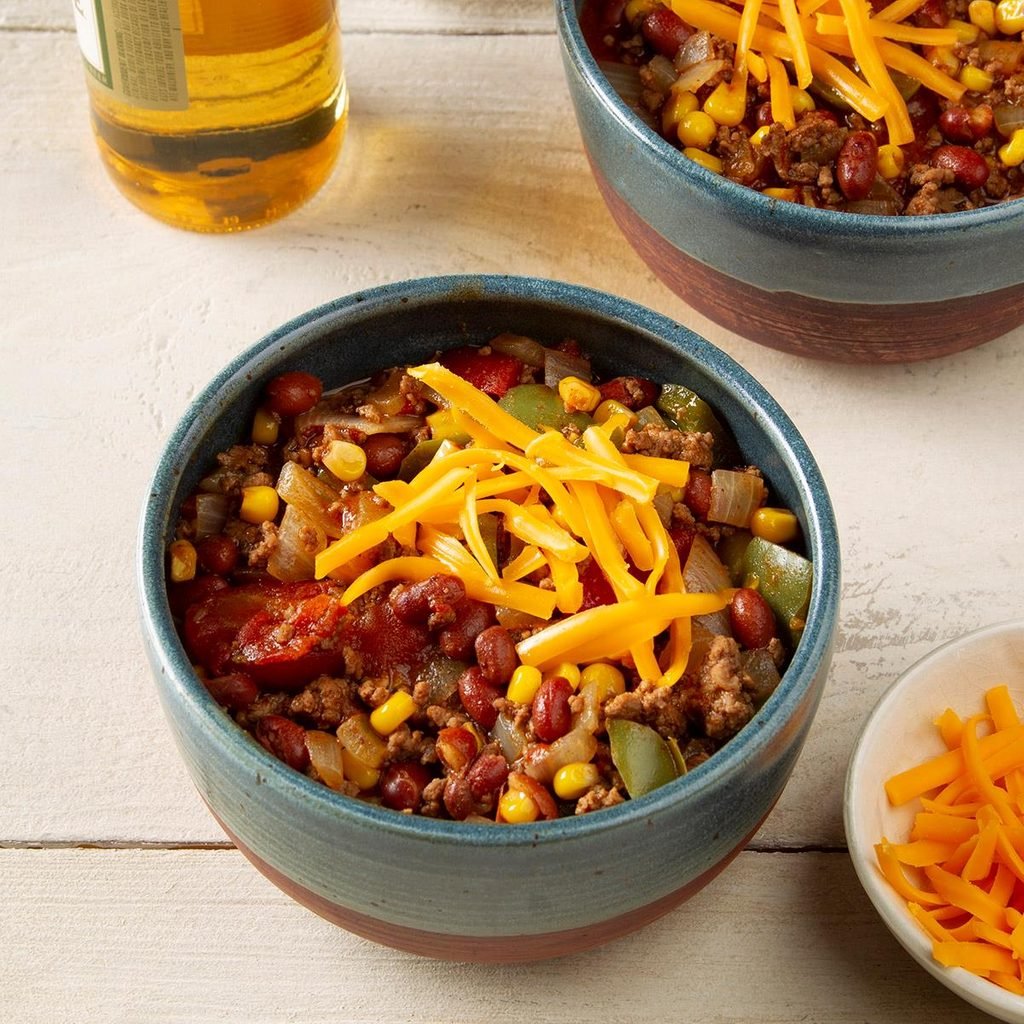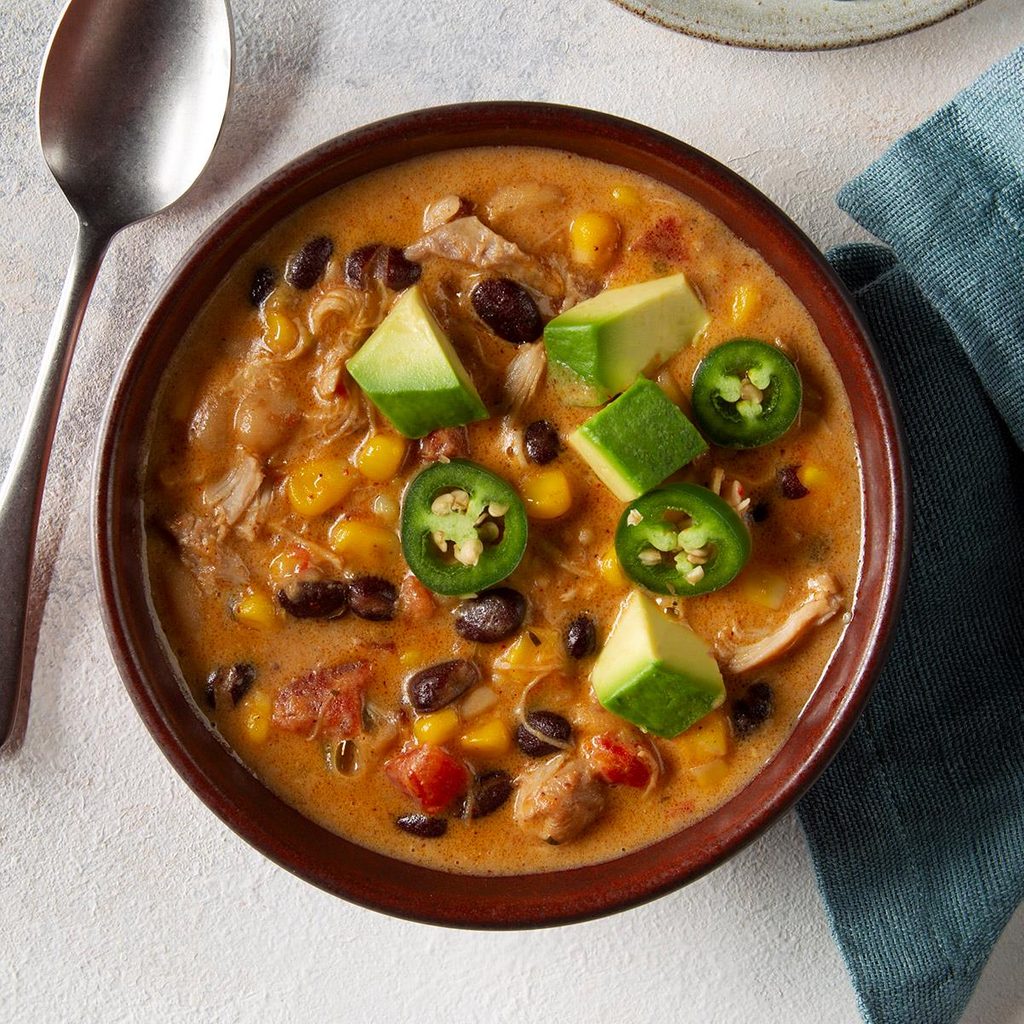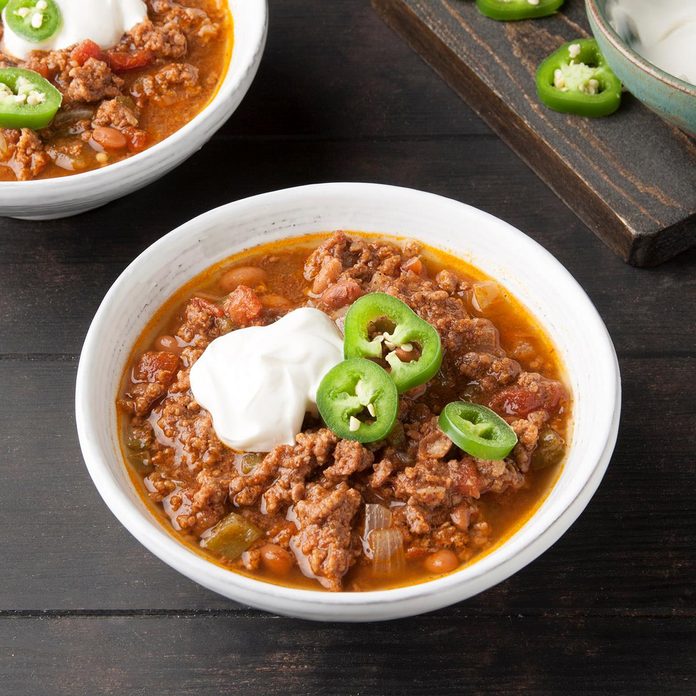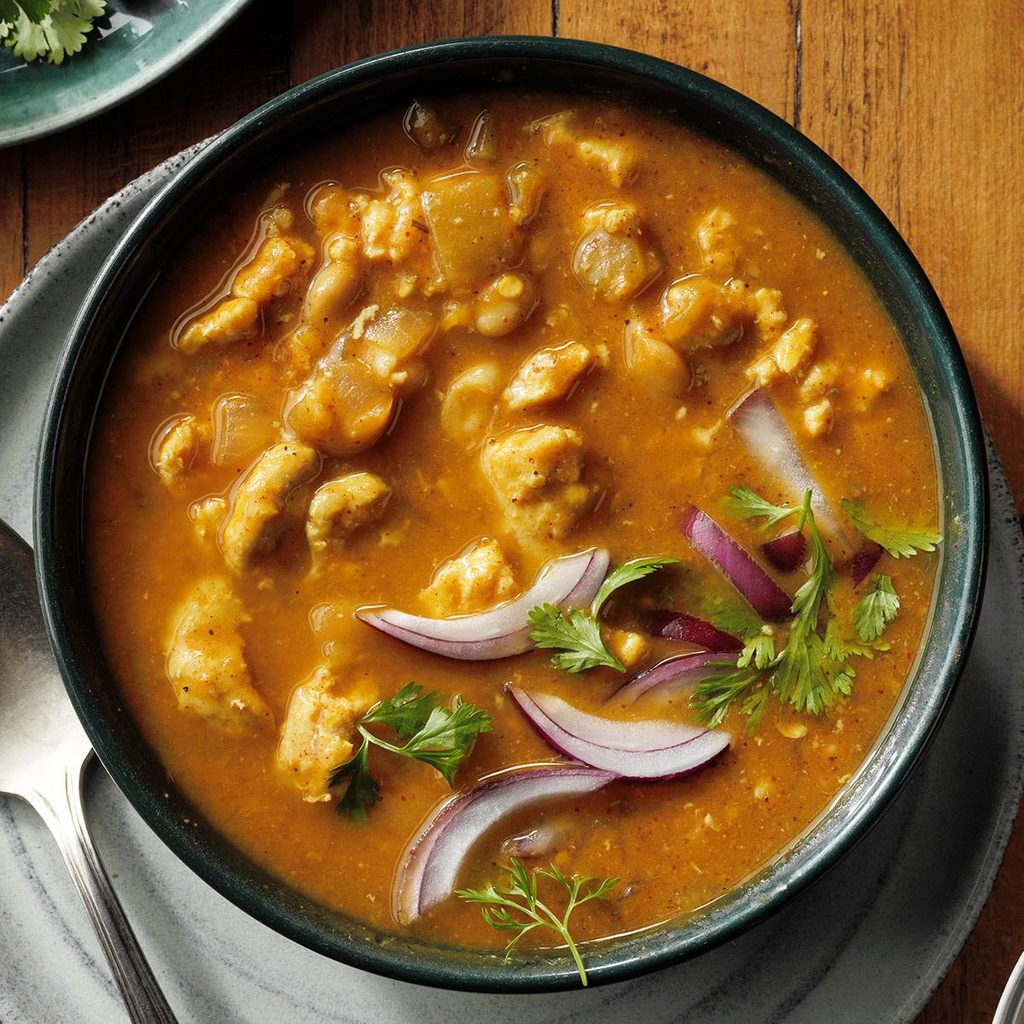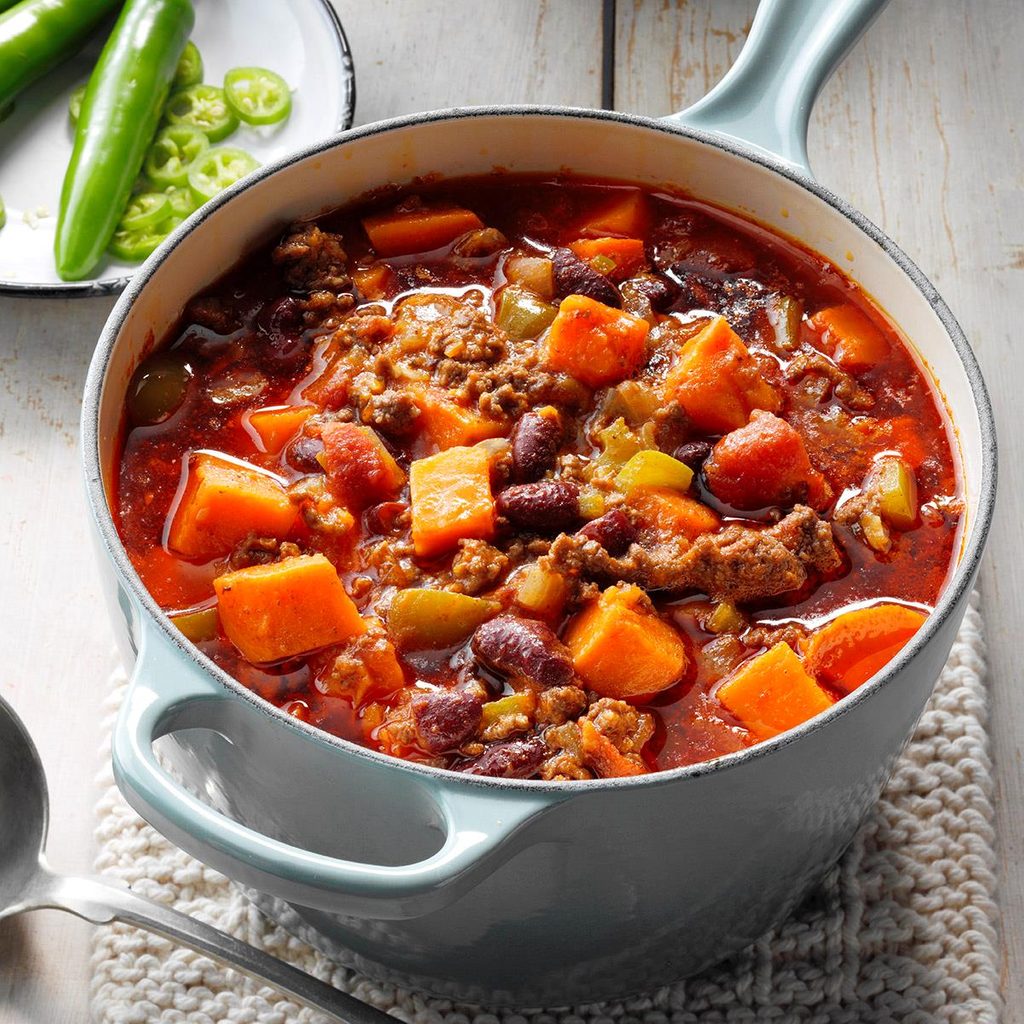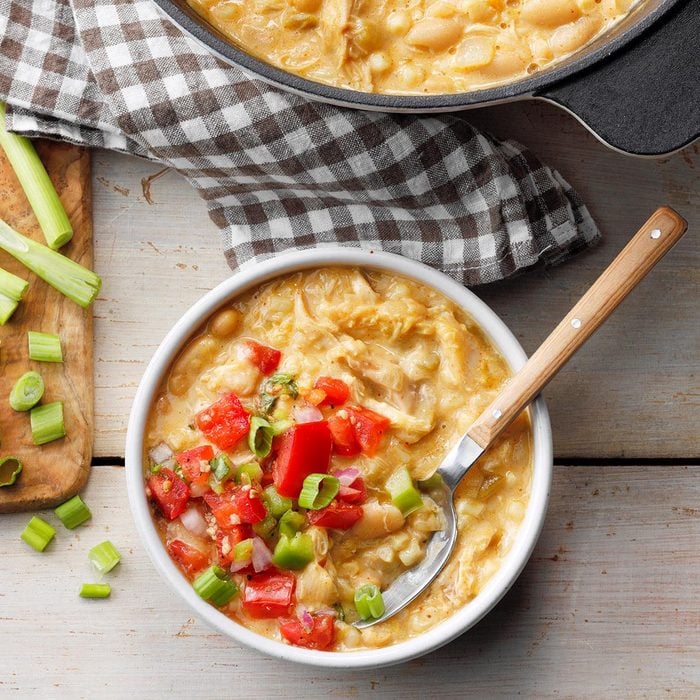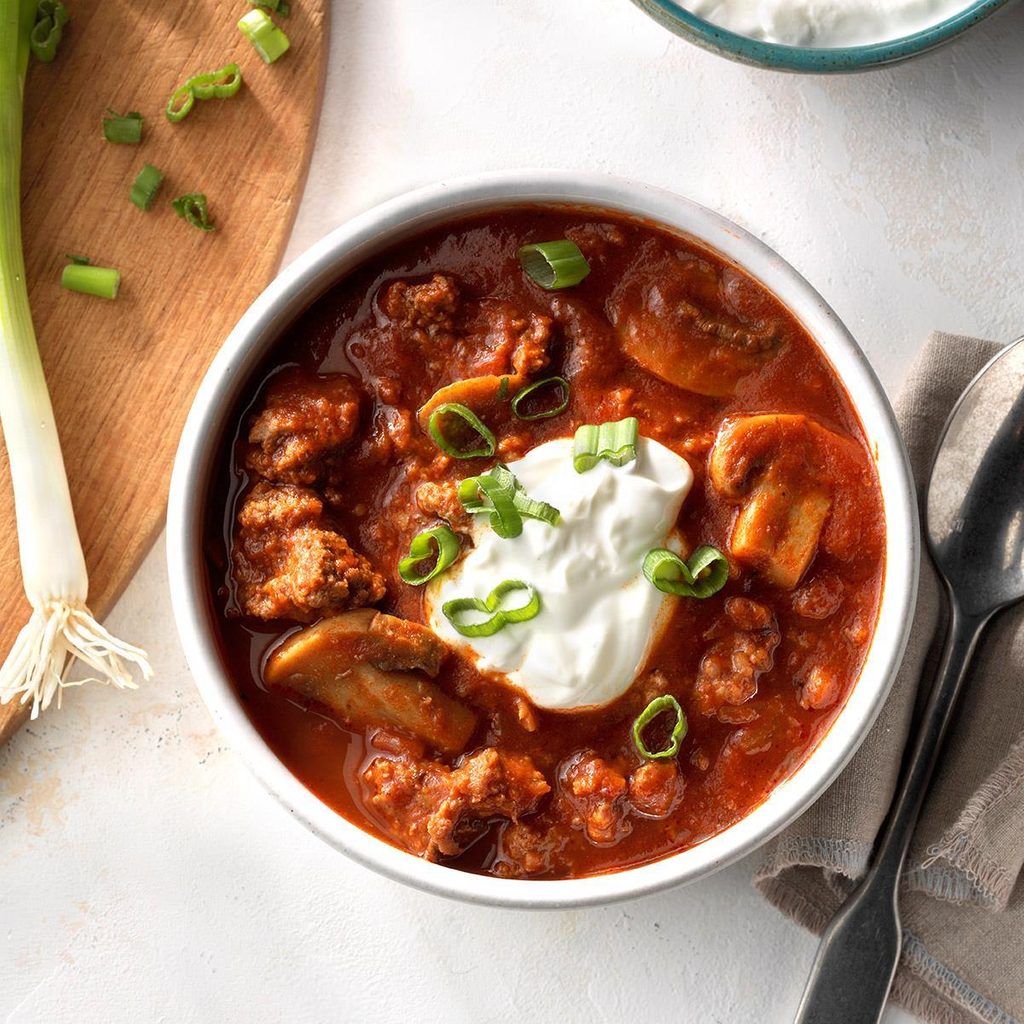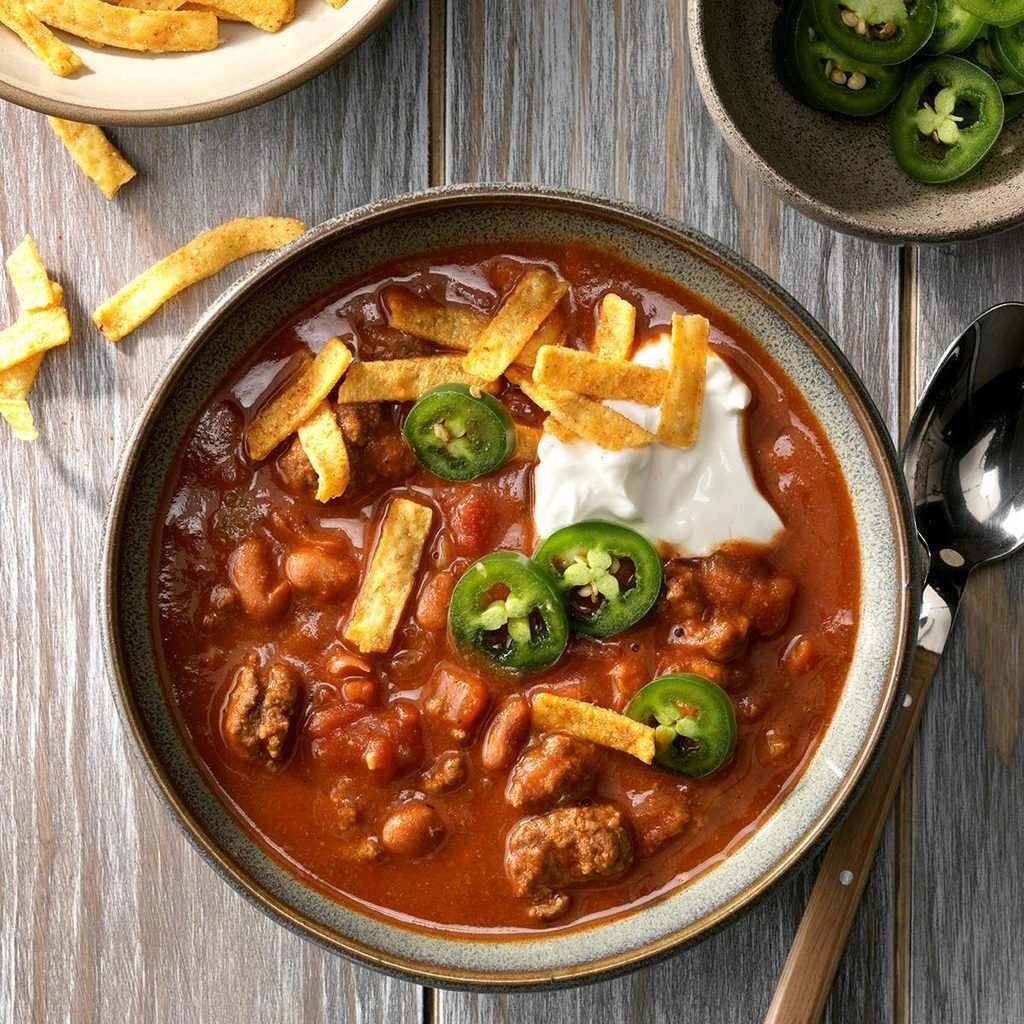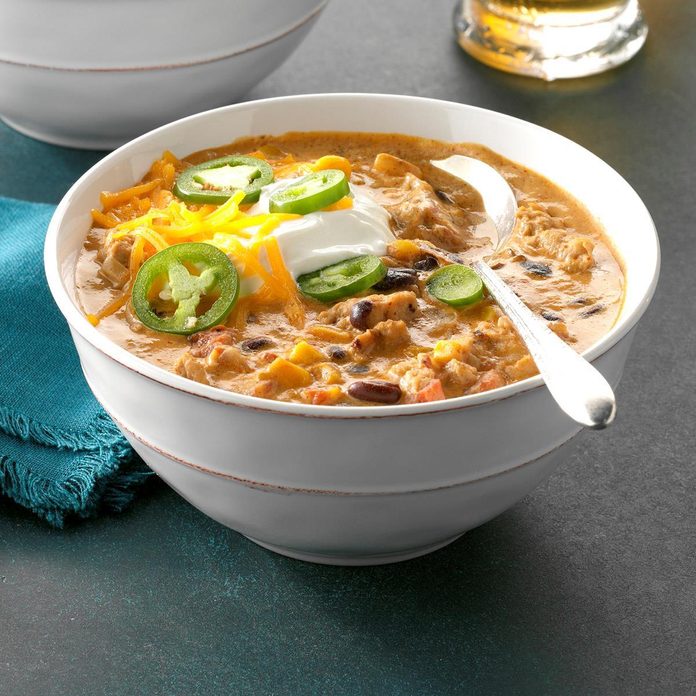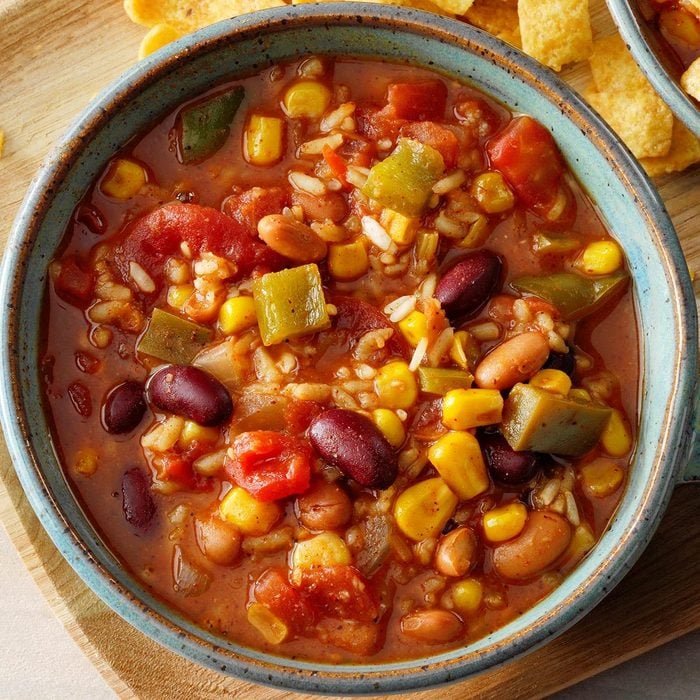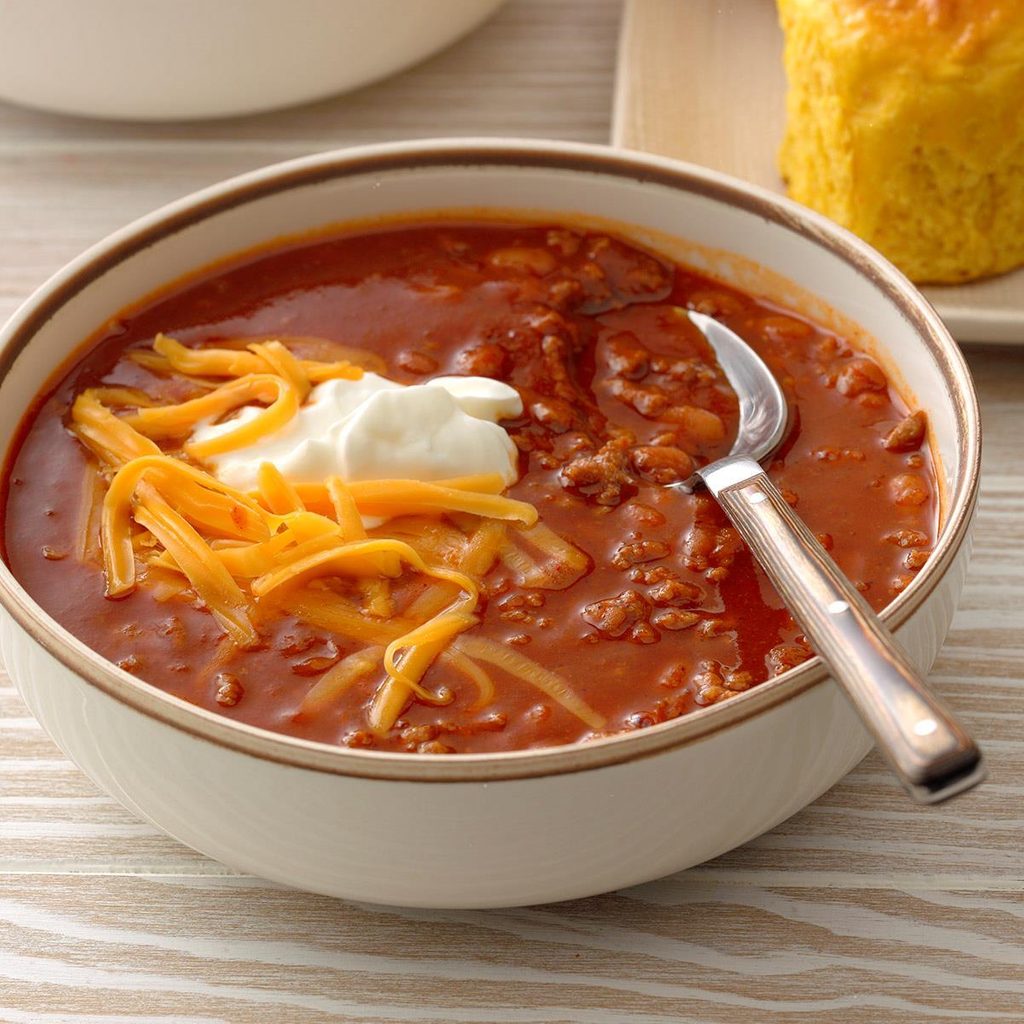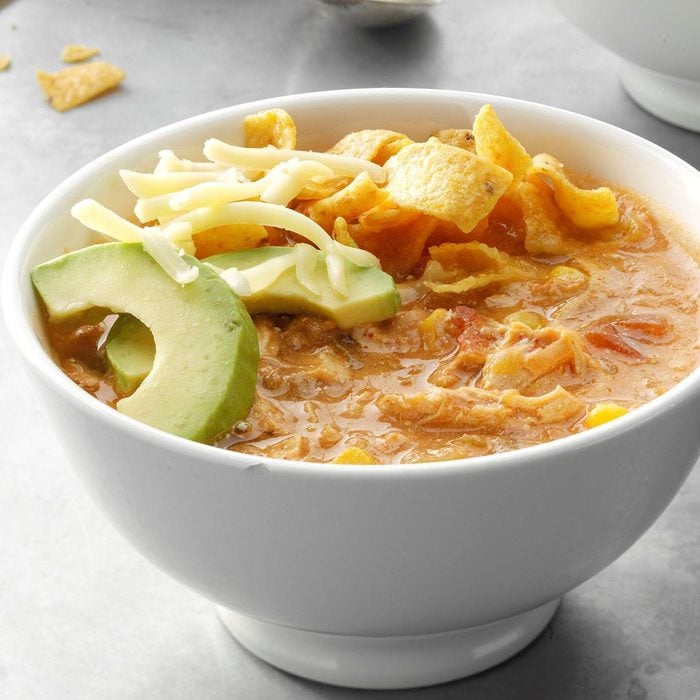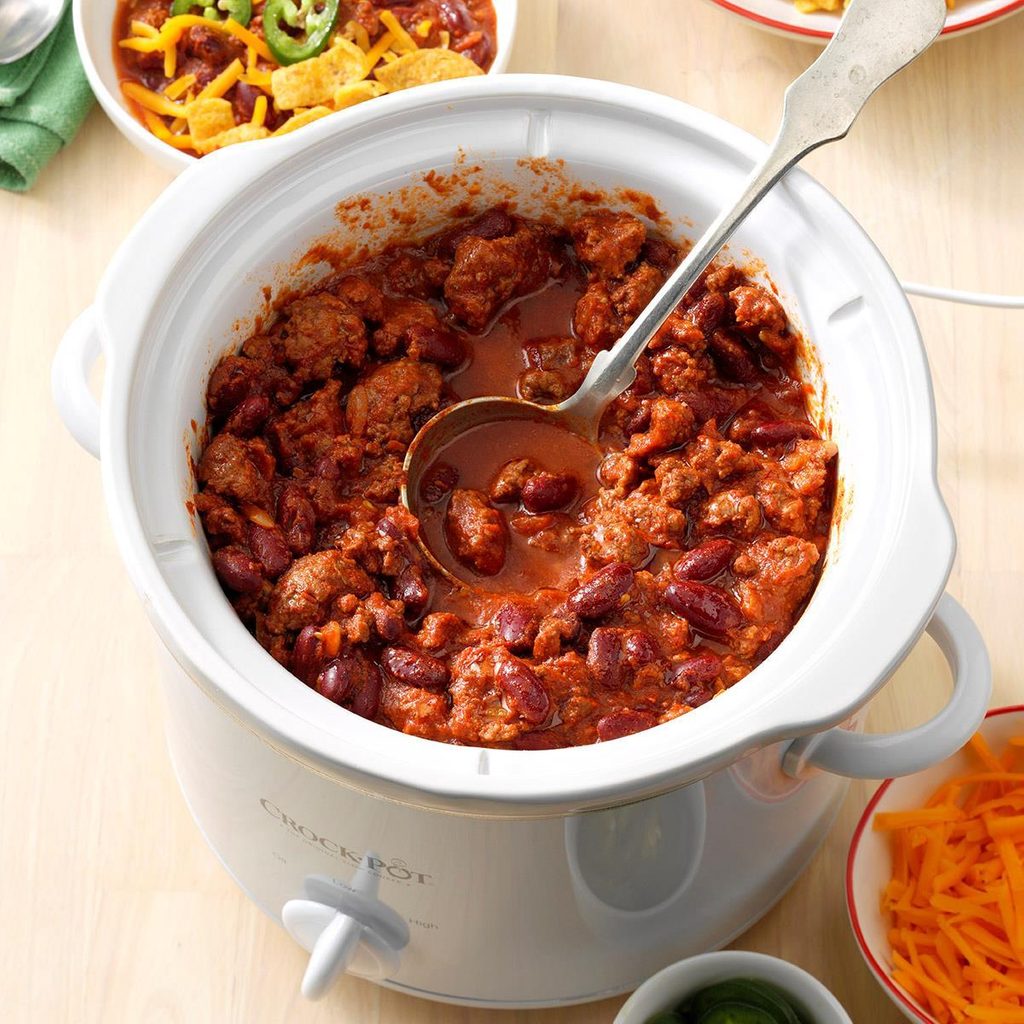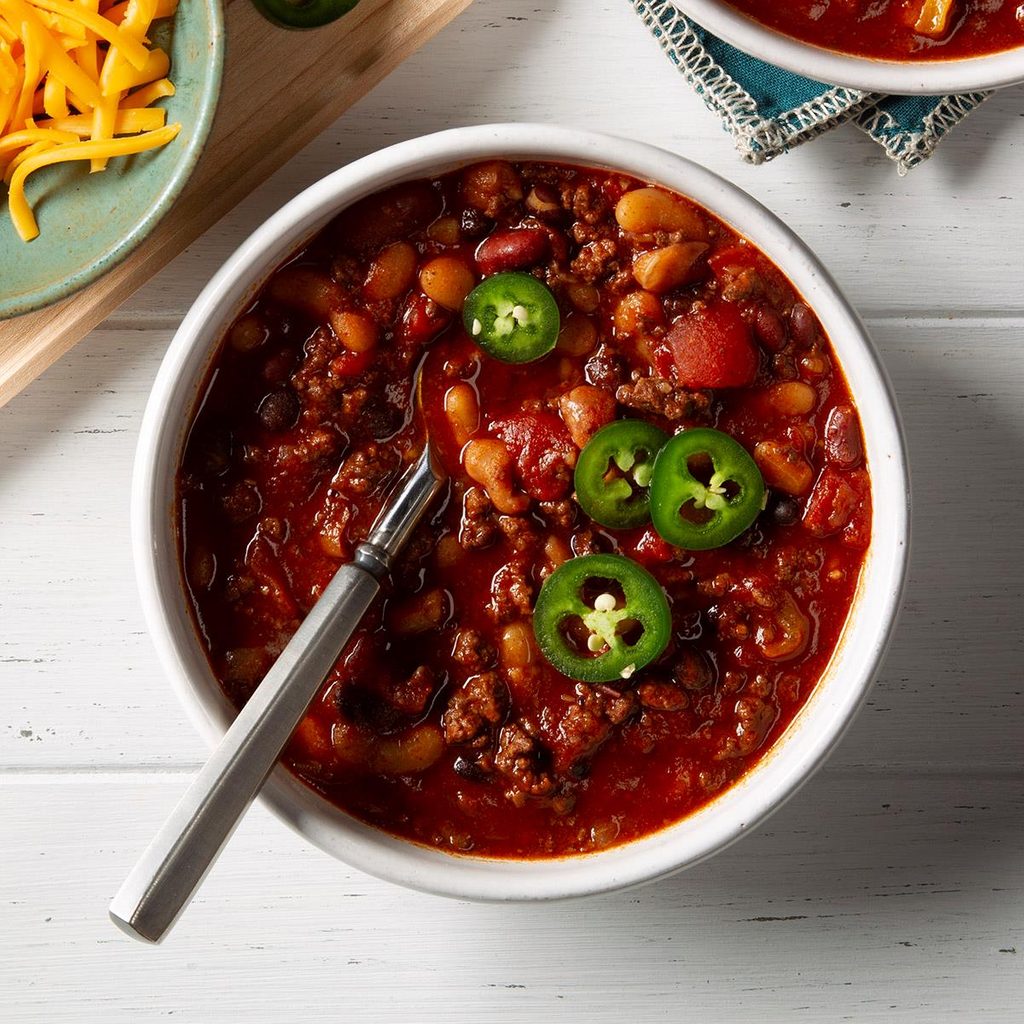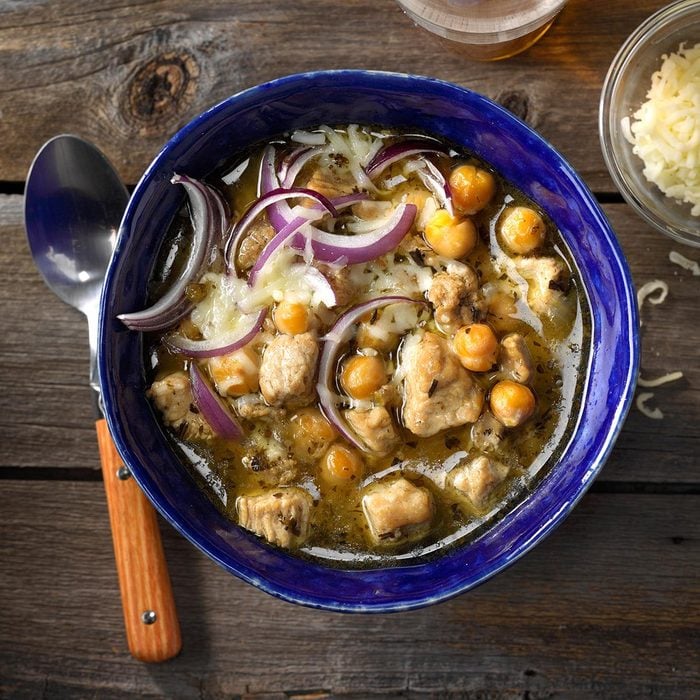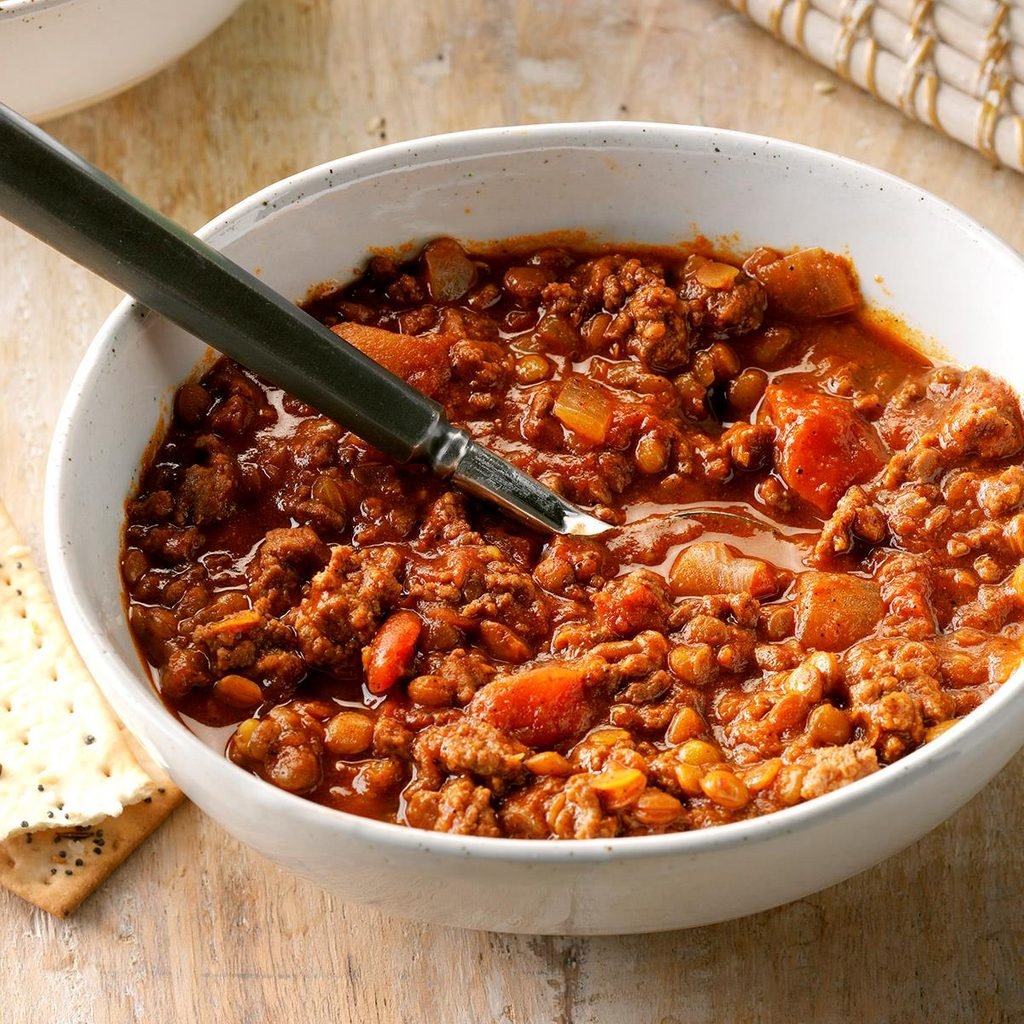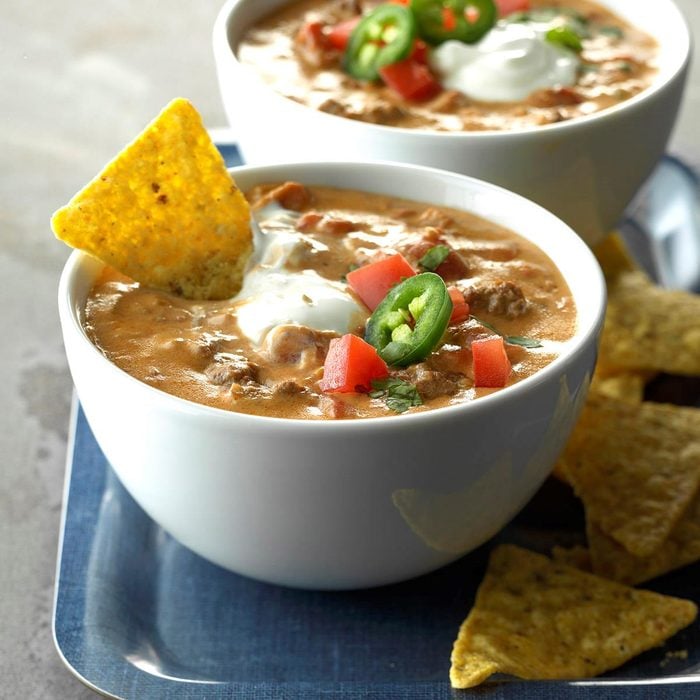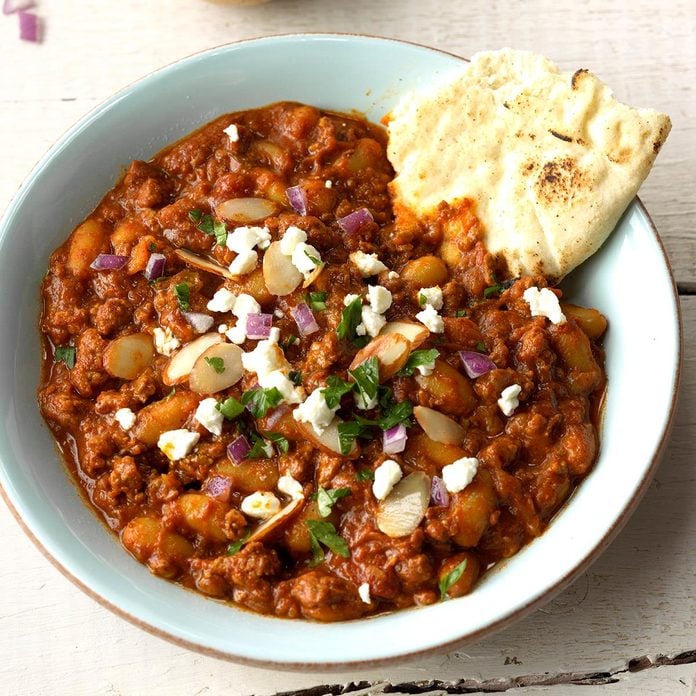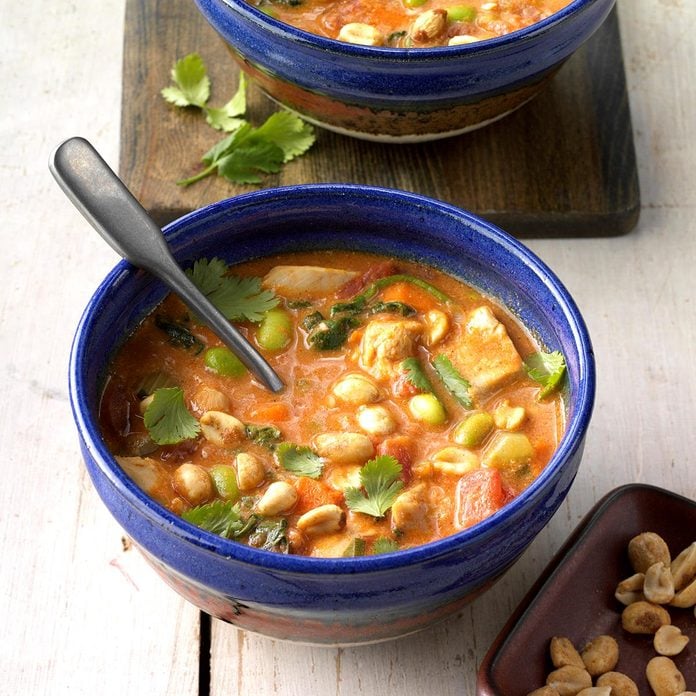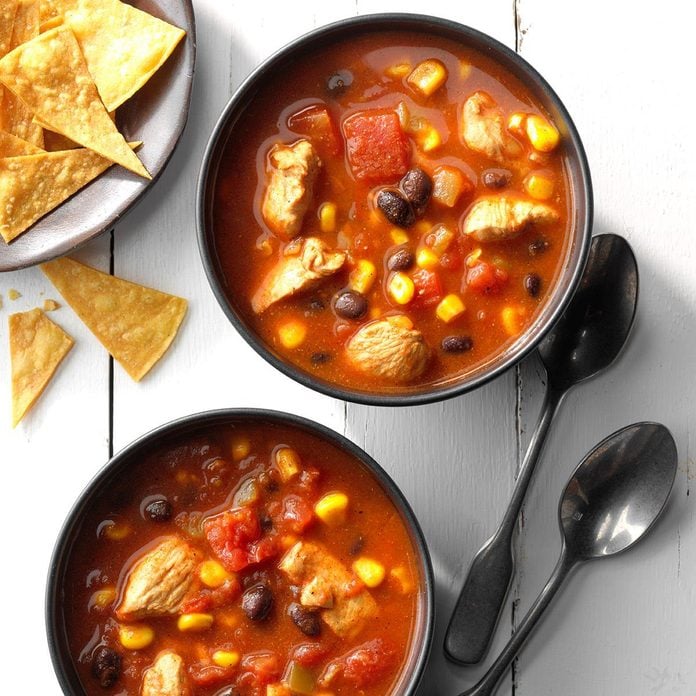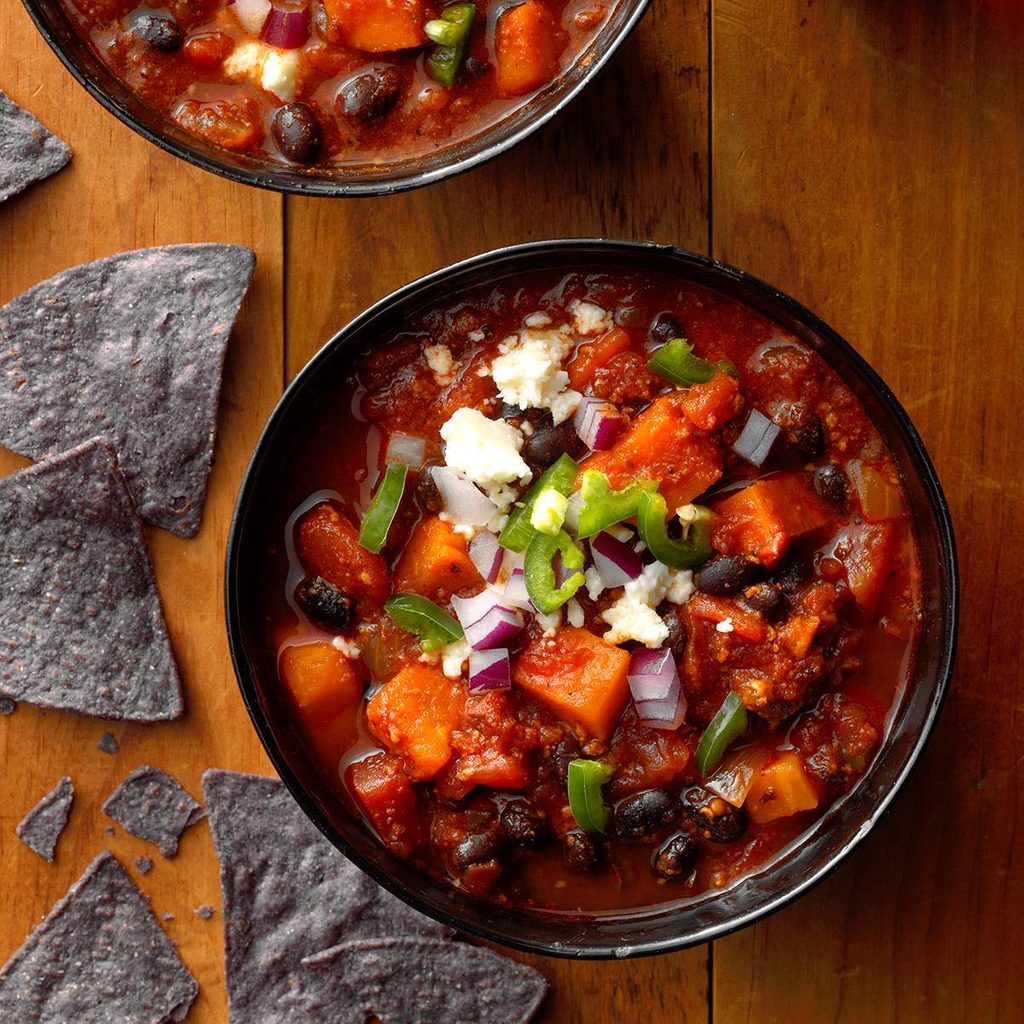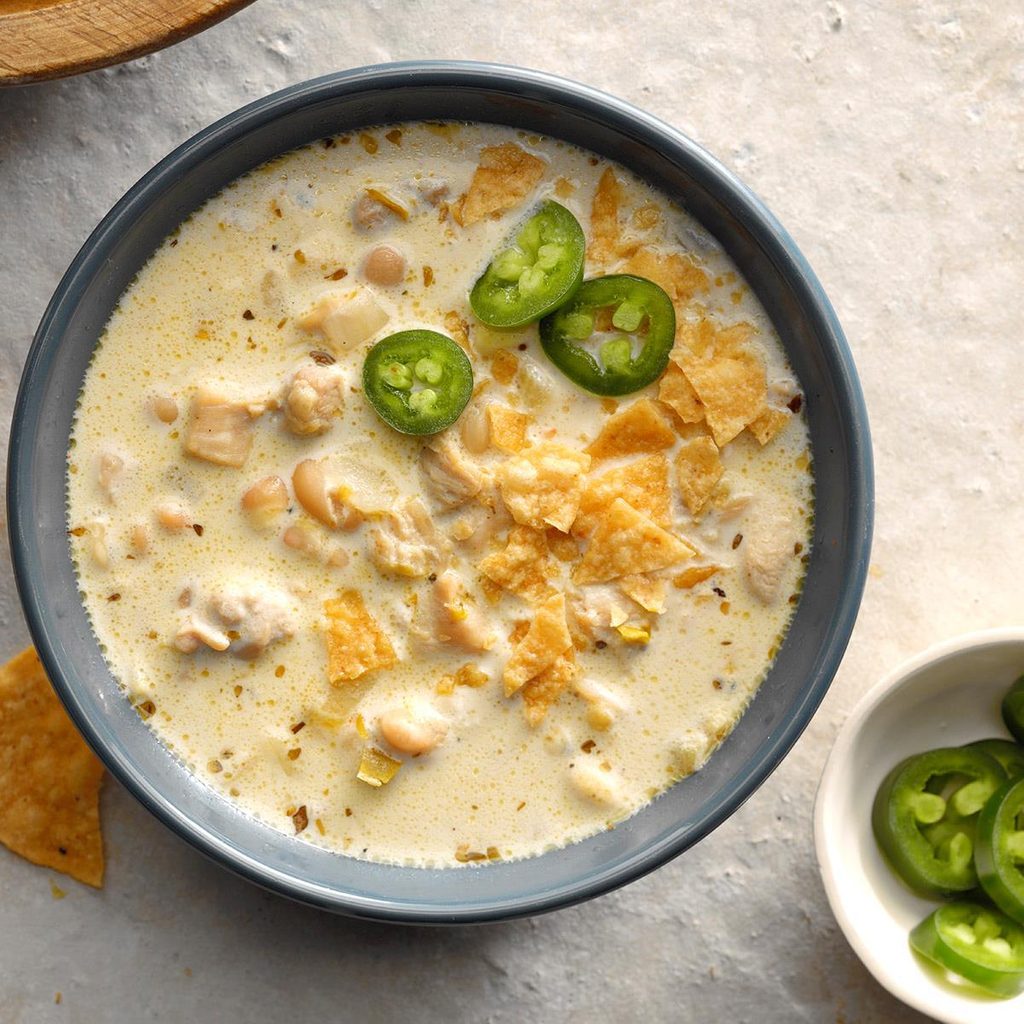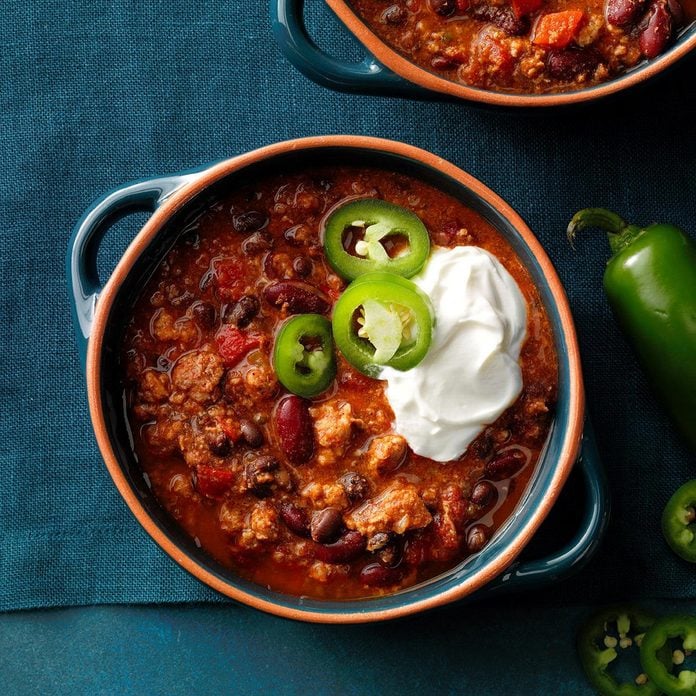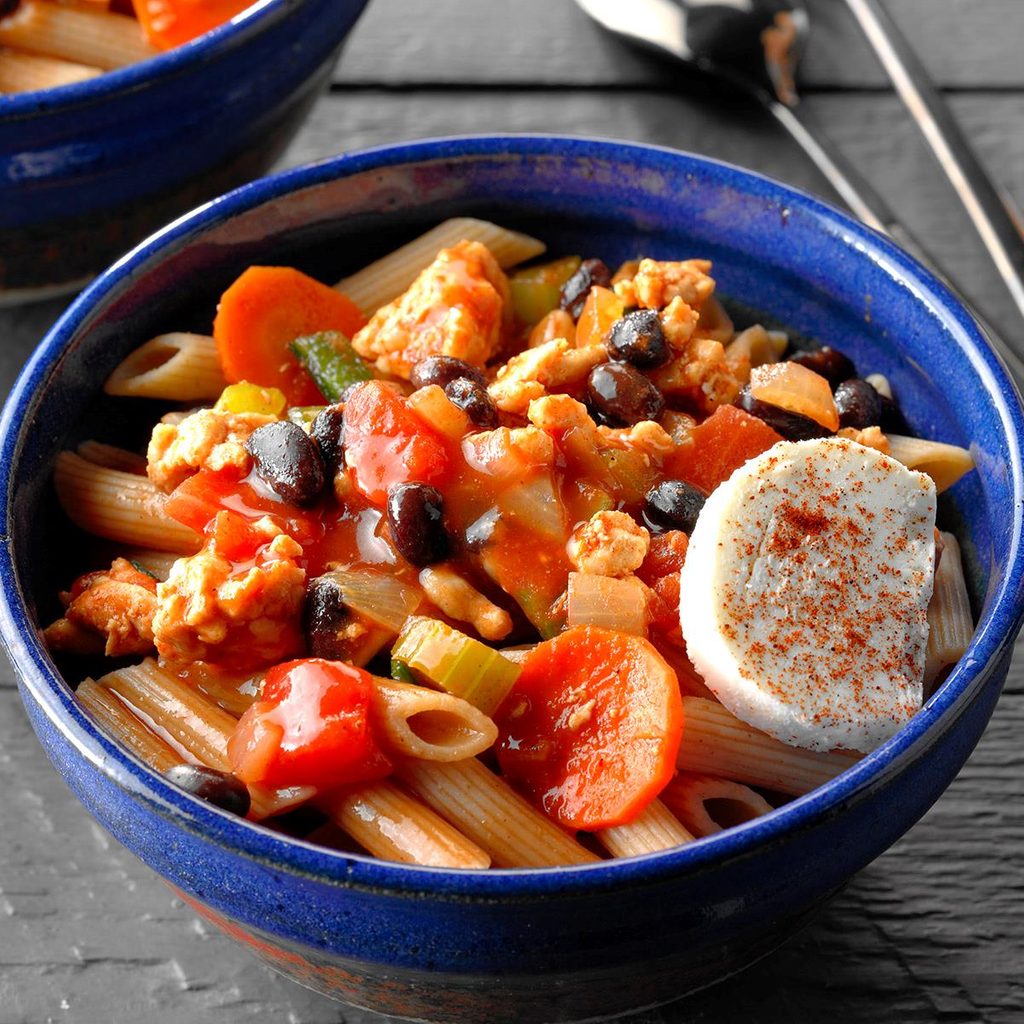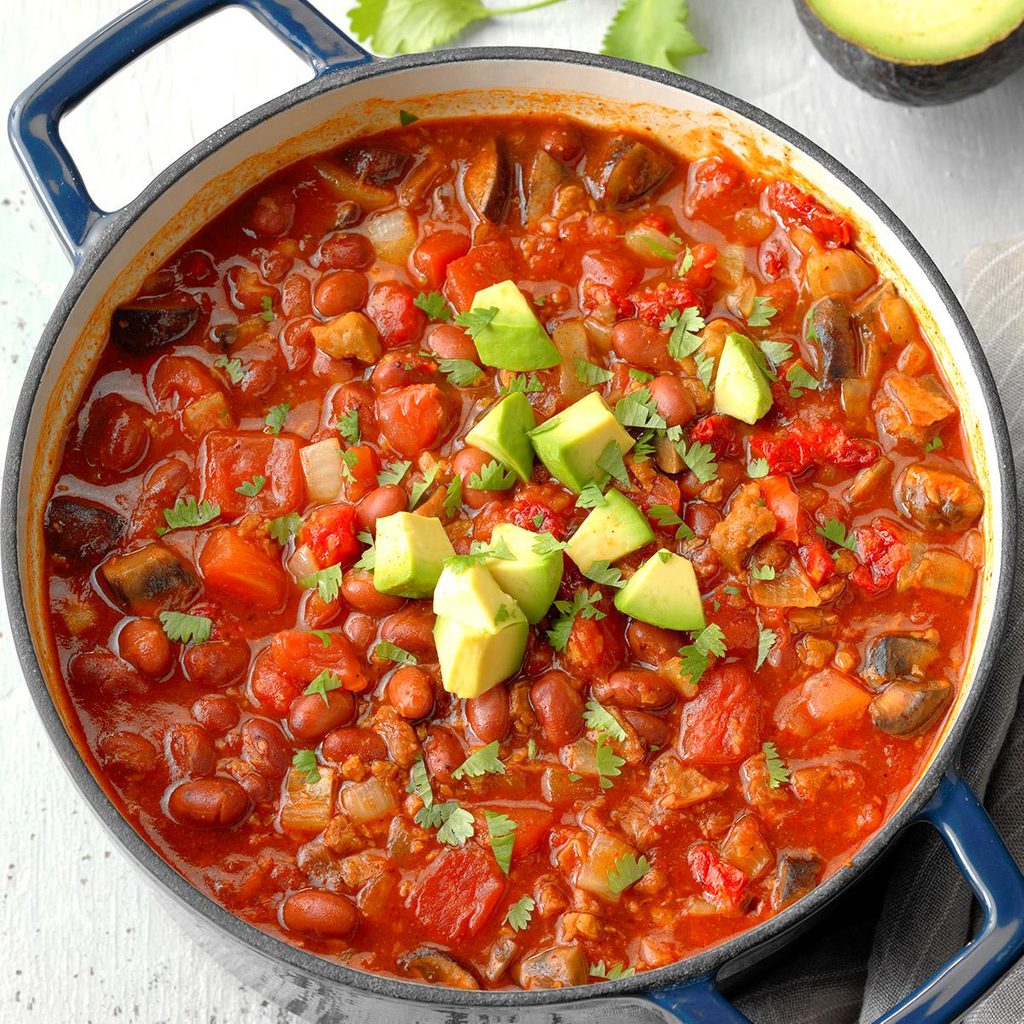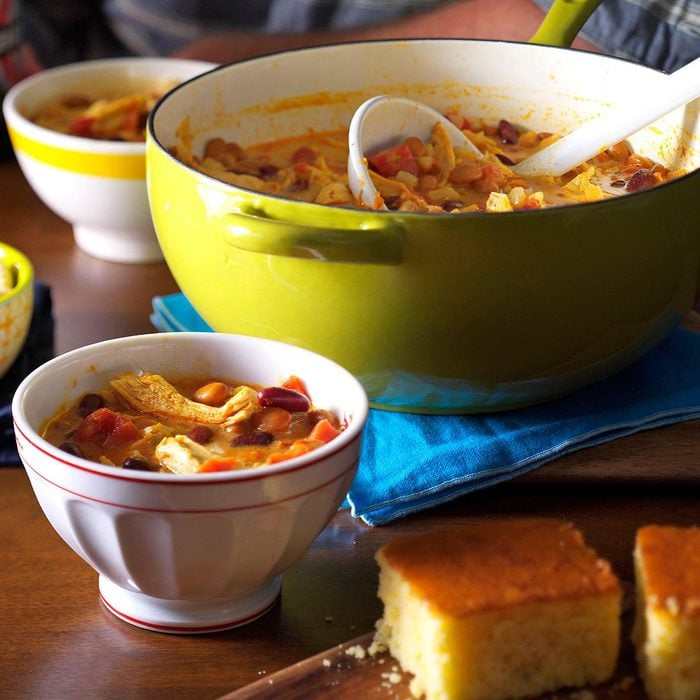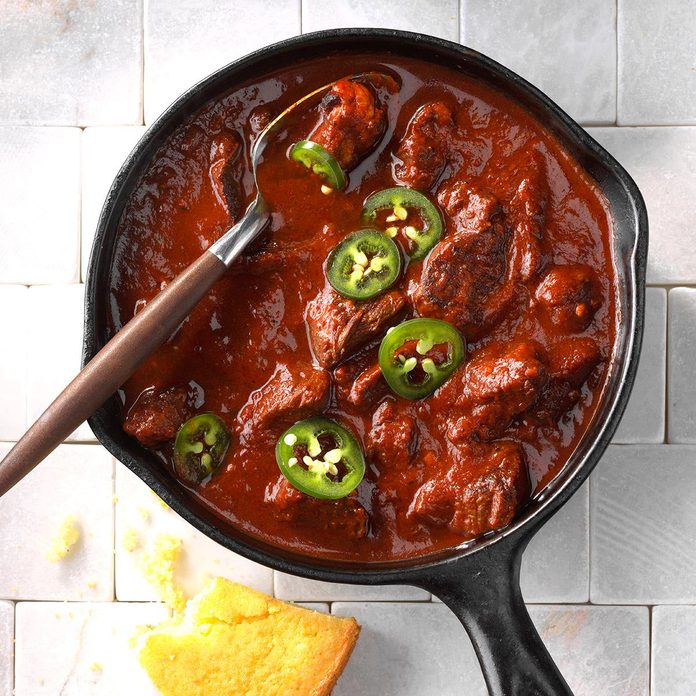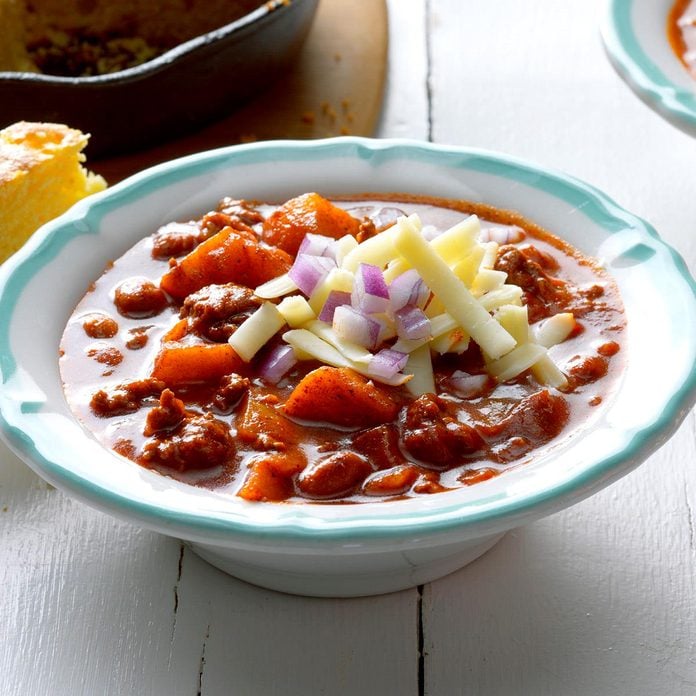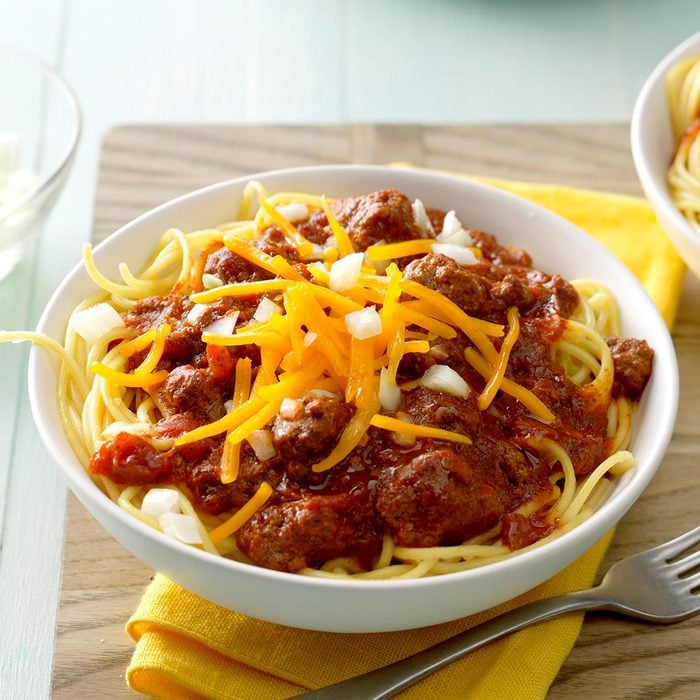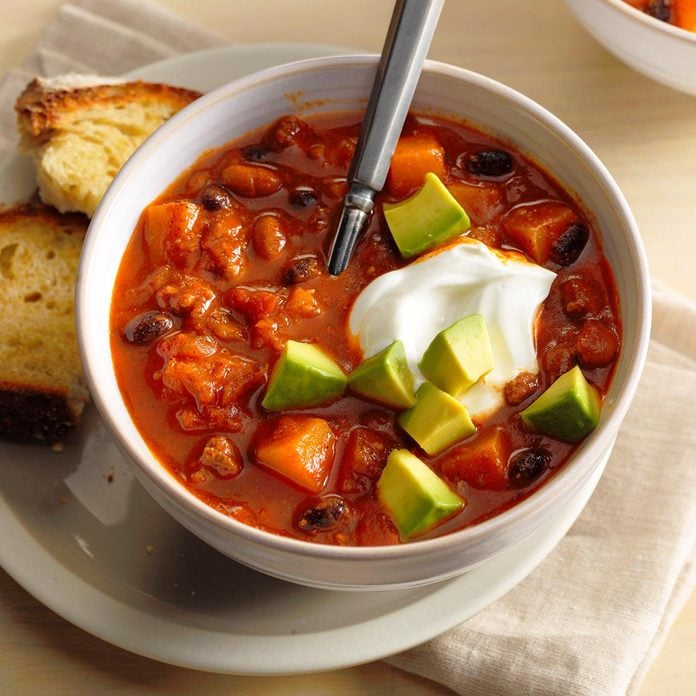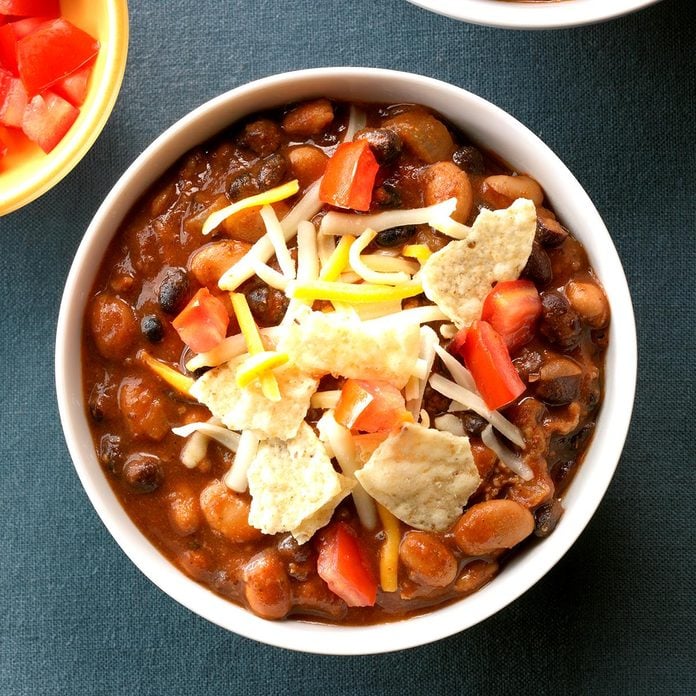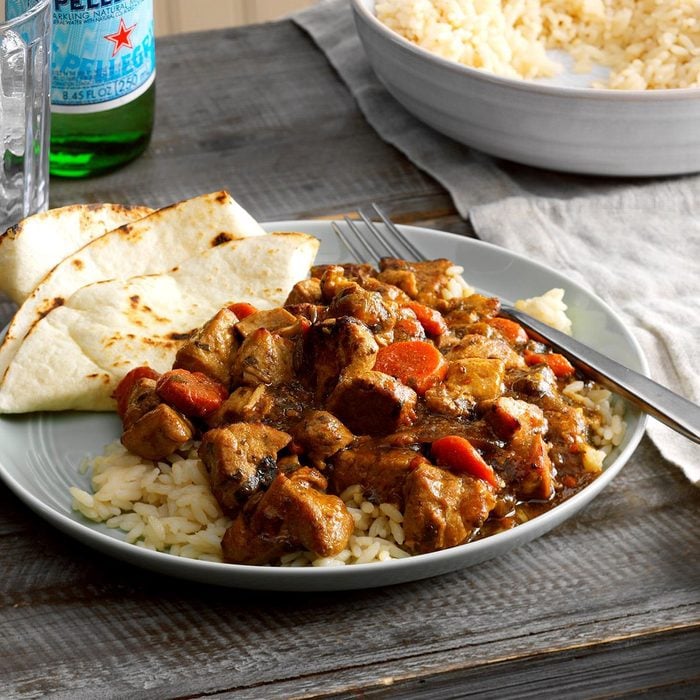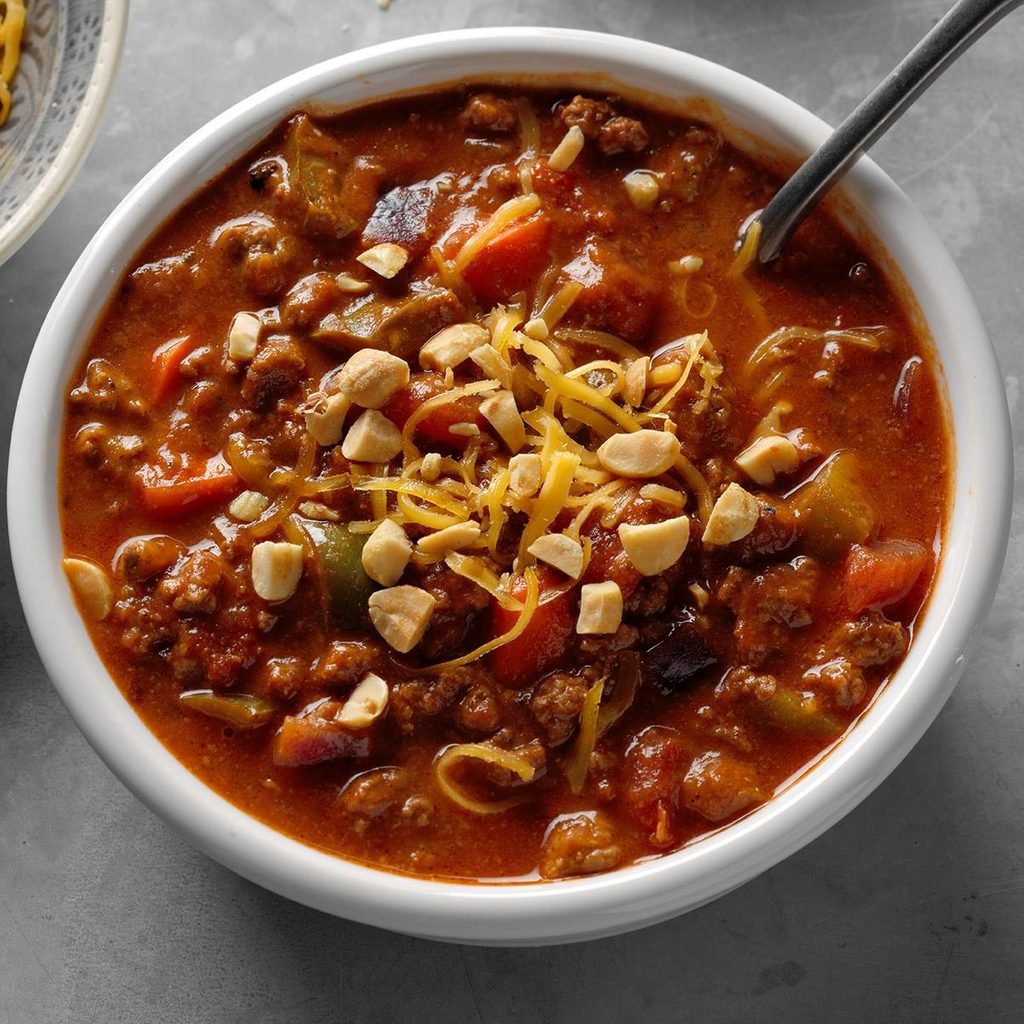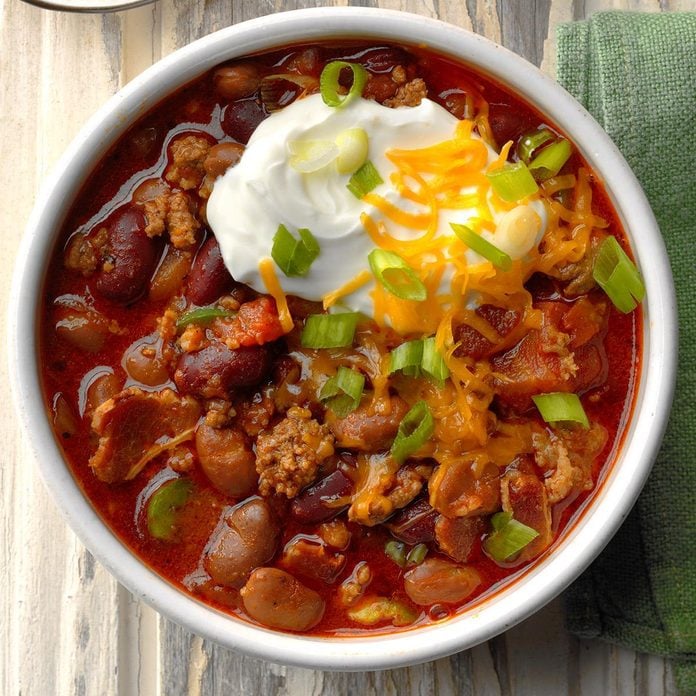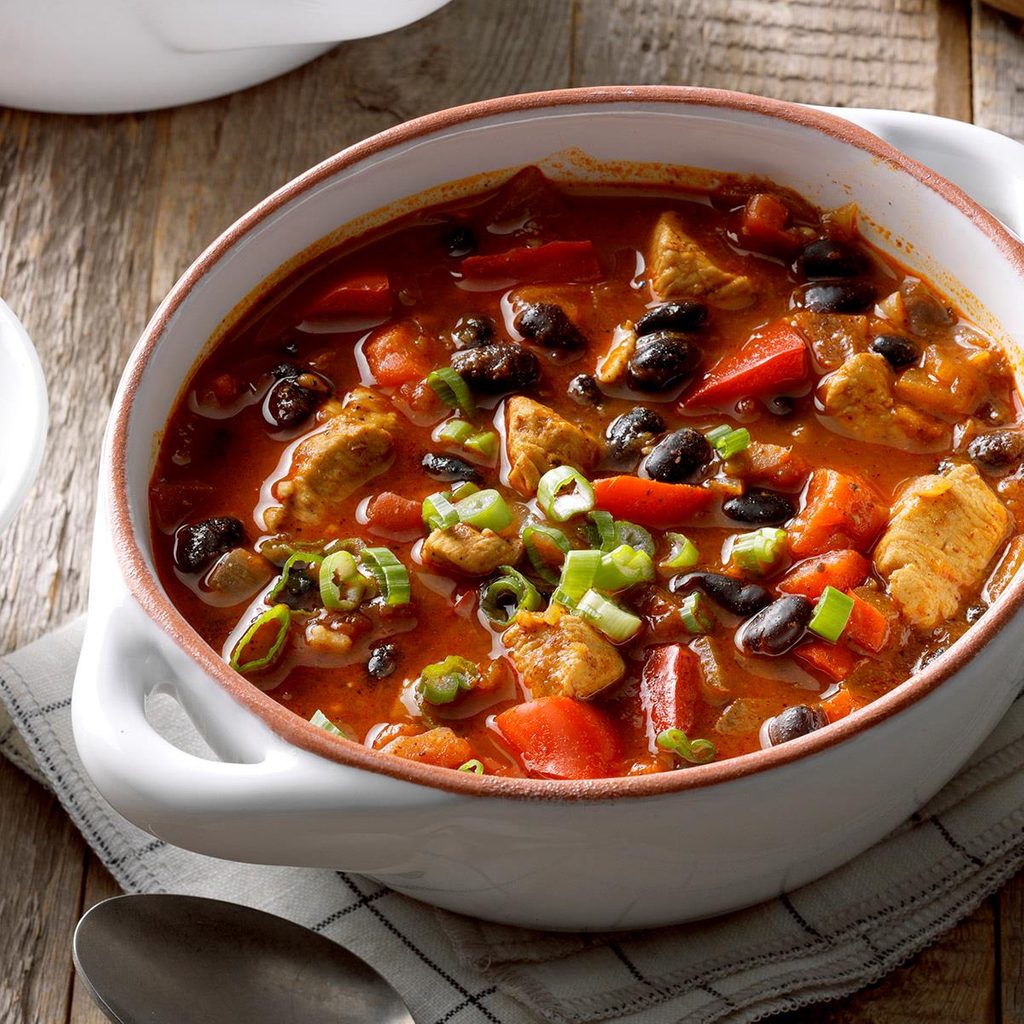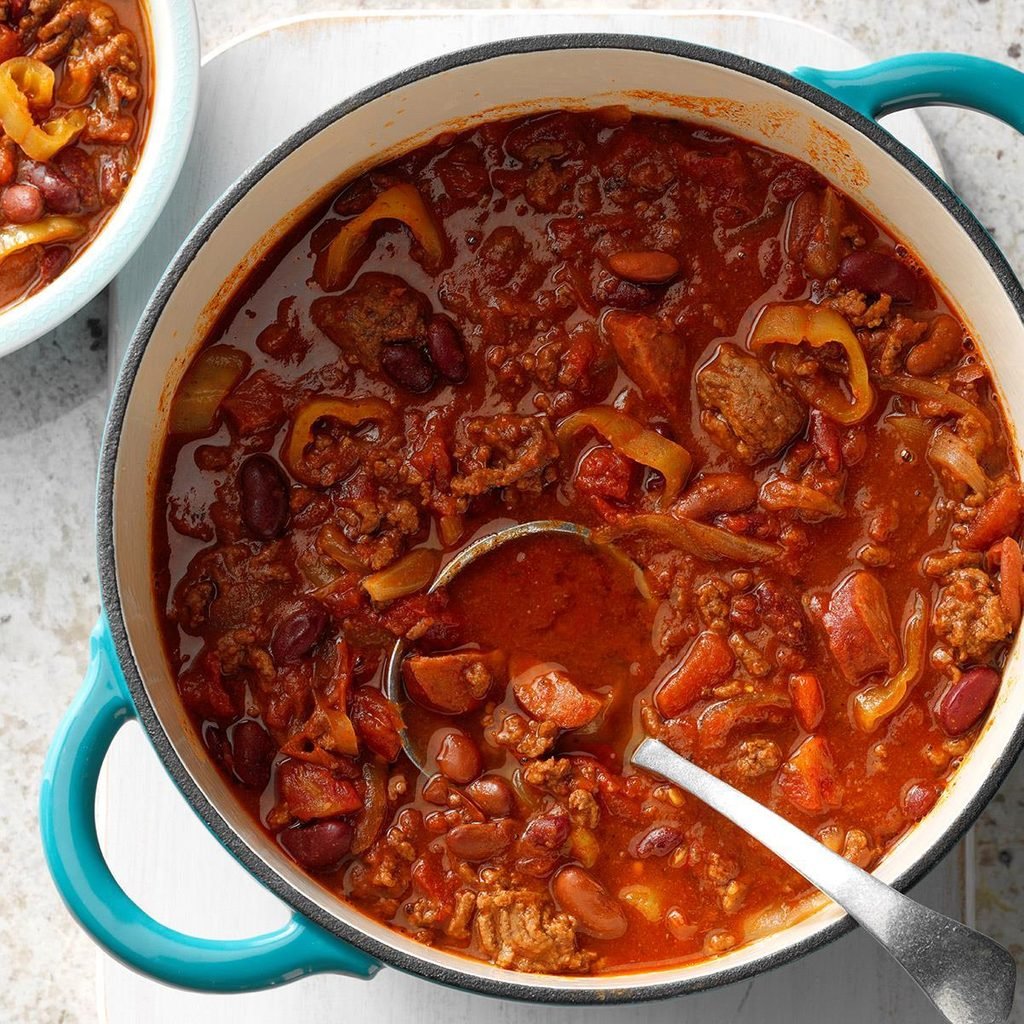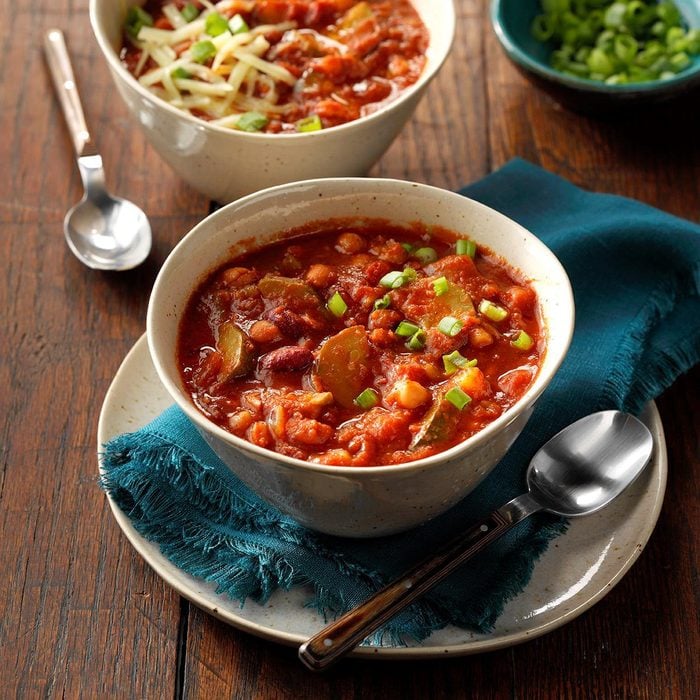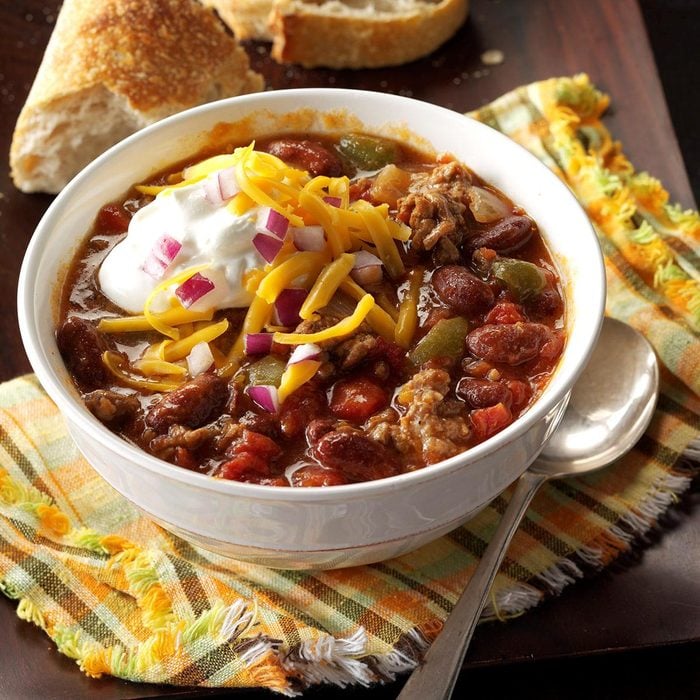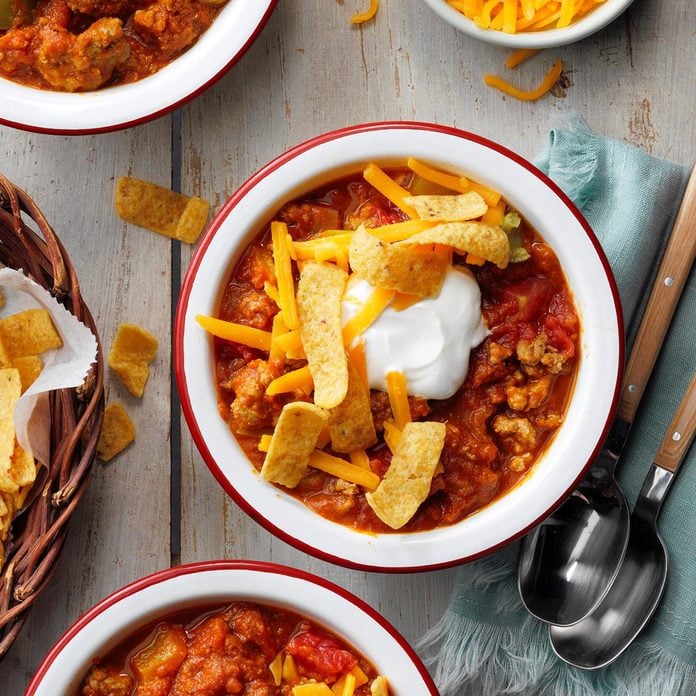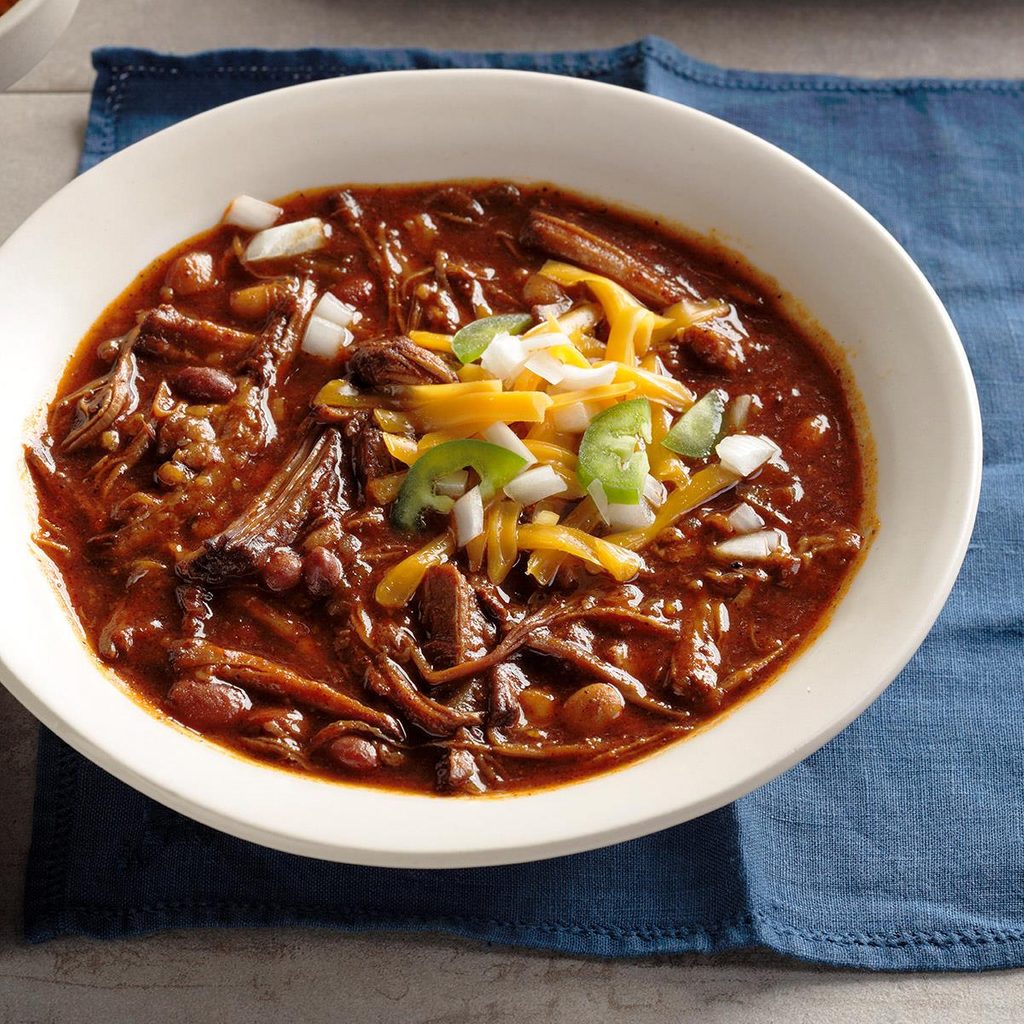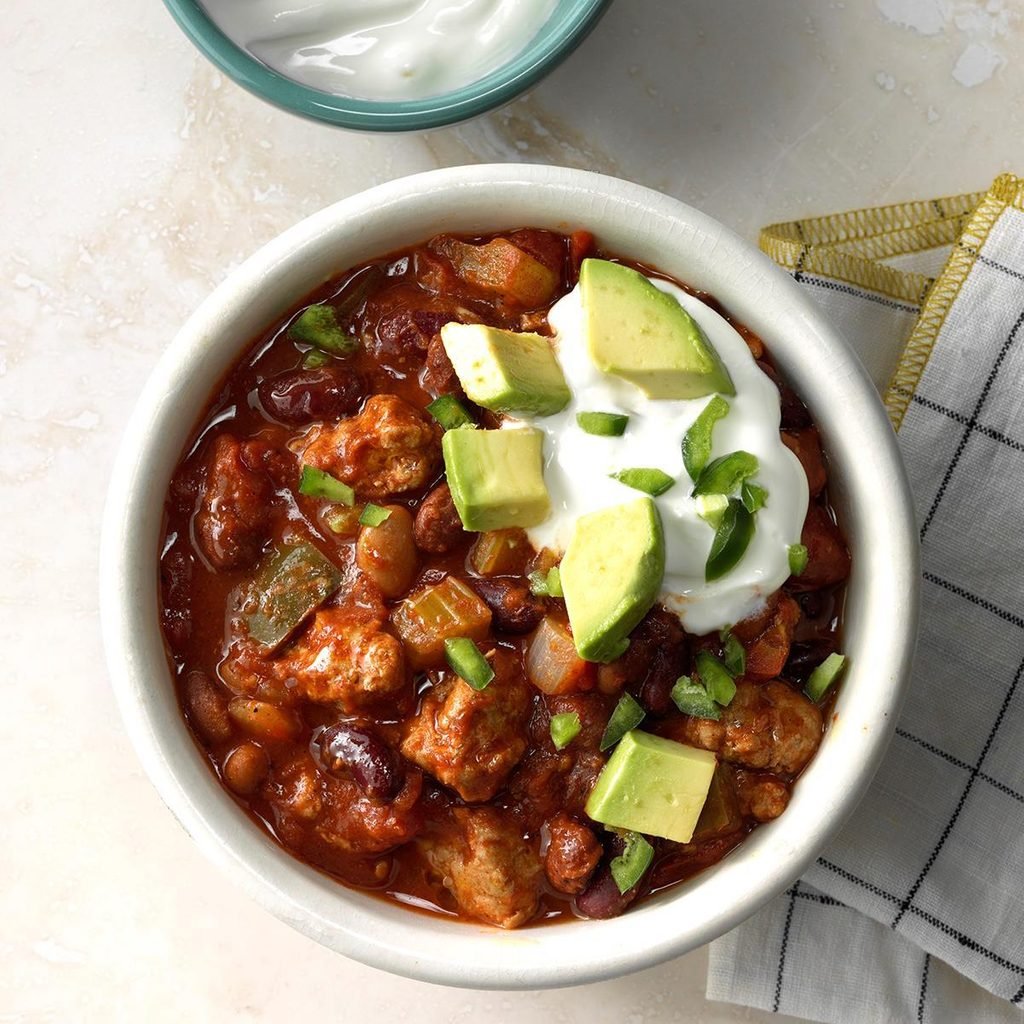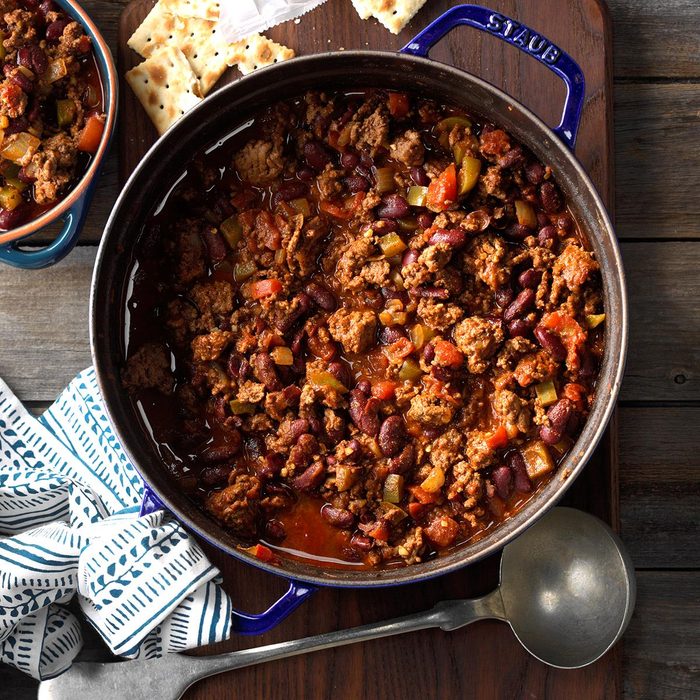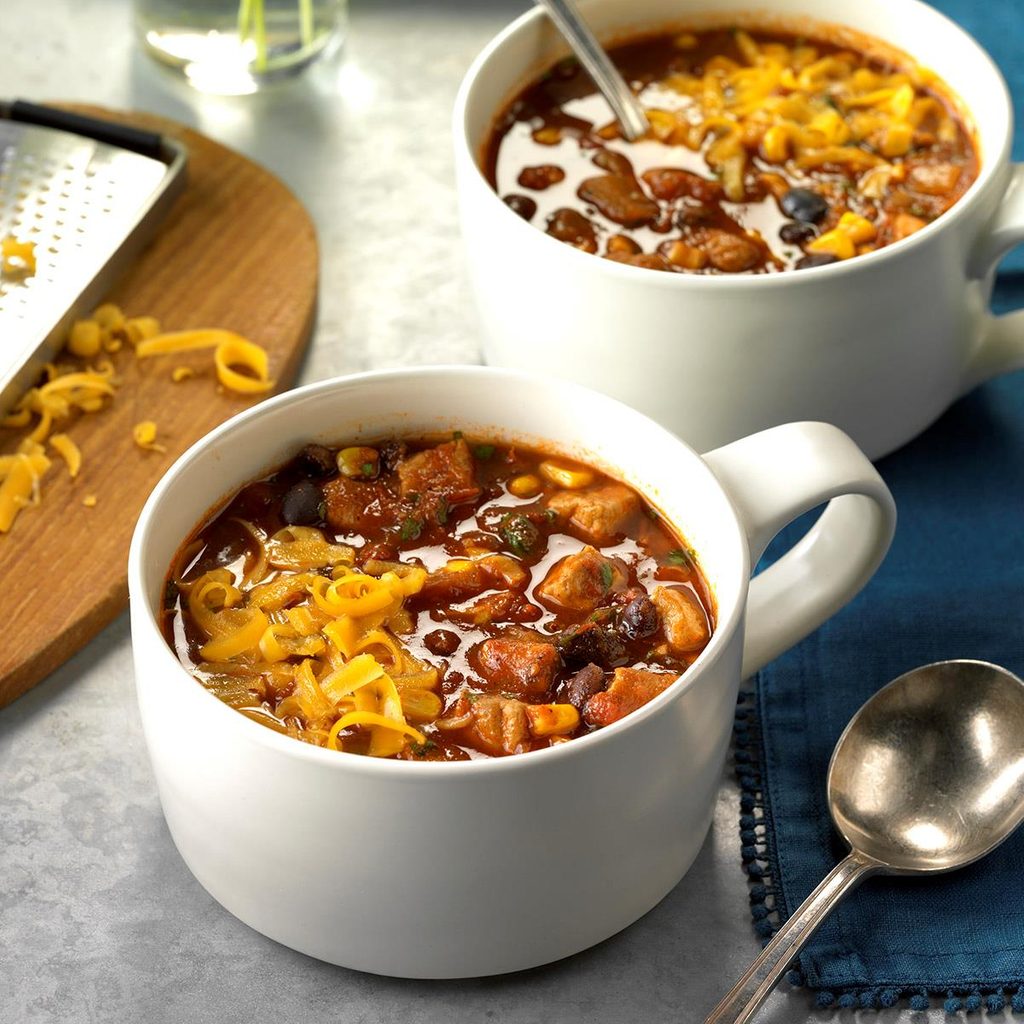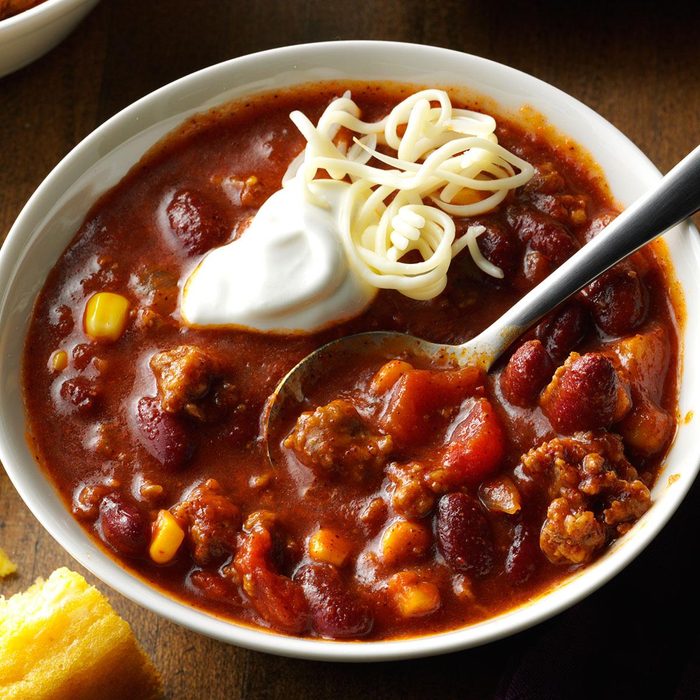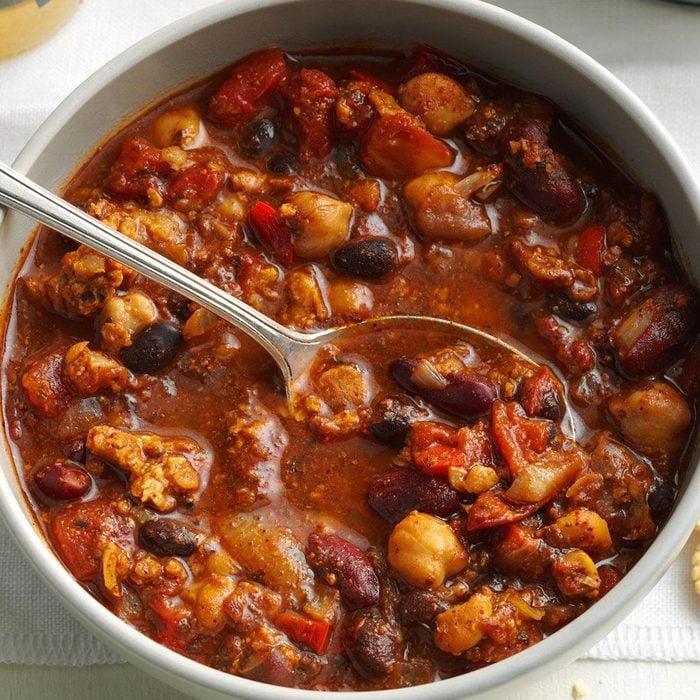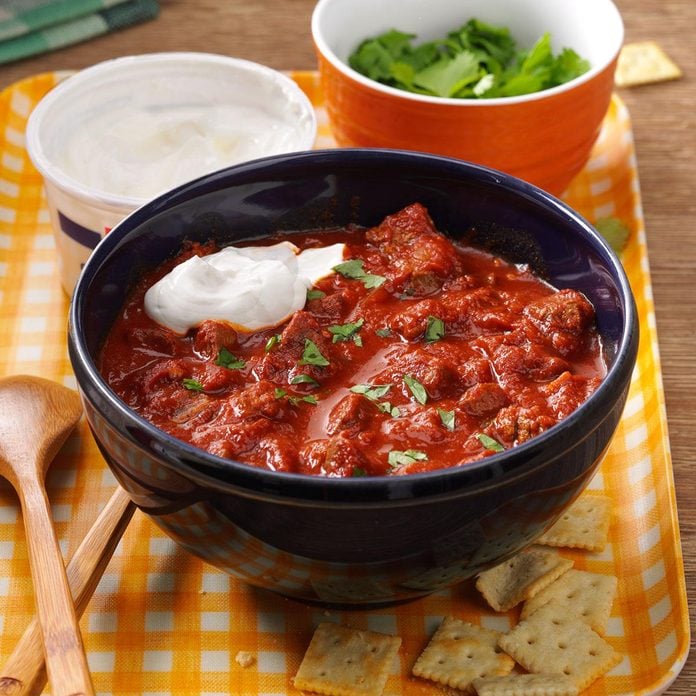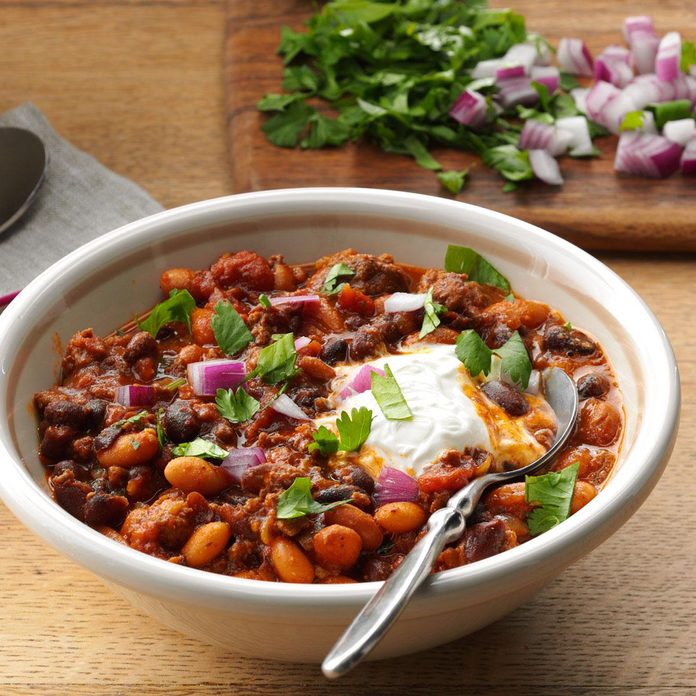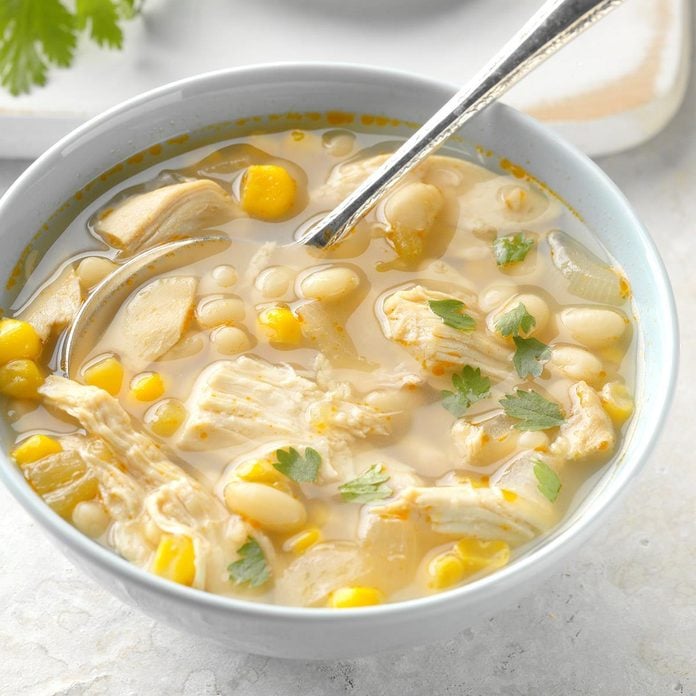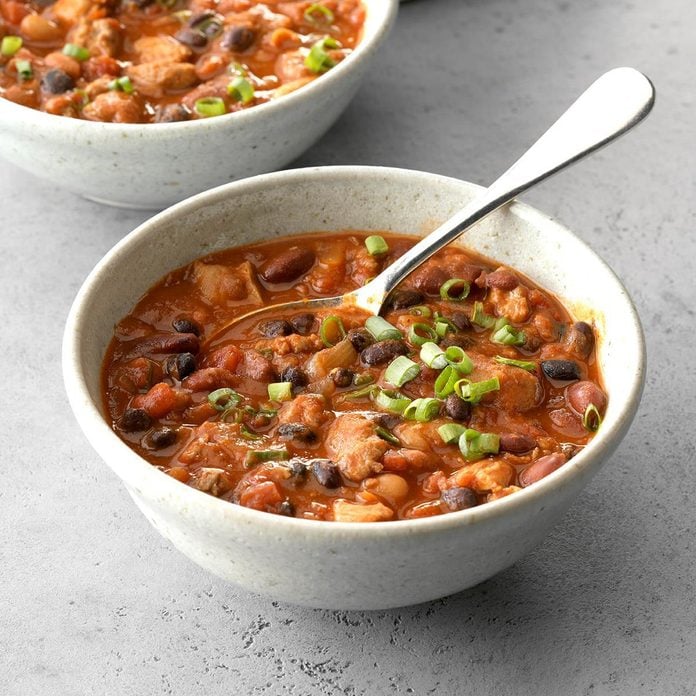Chili con Carne
My dad and father-in-law are the gurus in our chili-loving clan. But after my honeymoon to New Mexico, where I was inspired by the fresh and fragrant chile peppers at the Santa Fe farmers market, I felt it was time to introduce them to my spicy, meaty version with a touch of masa harina. —Sarah Farmer, Taste of Home Culinary Director
Go to Recipe
Here's another
beef chili recipe we think you'll love!
The Best Ever ChiliMy dad and father-in-law are the gurus in our chili-loving clan. But after my honeymoon to New Mexico, where I was inspired by the fresh and fragrant chile peppers at the Santa Fe farmers market, I felt it was time to introduce them to my spicy, meaty version with a touch of masa harina. —Sarah Farmer, Taste of Home Culinary Director
Sweet Potato & Black Bean ChiliMy whole family enjoys this sweet potato black bean chili, but my daughter especially loves it. I like to make it because it's so easy and very flavorful. —Joy Pendley, Ortonville, Michigan. Be sure to check out our collection of the best
vegetarian chili soups.
Spicy Montana ChiliThis thick and chunky chili has some kick to it. I like to top it with shredded cheddar and then serve it with a side of cornbread. —Donna Evaro, Casper, Wyoming
Flavorful White Chicken ChiliLime, cumin and cilantro really create a burst of flavor in this chicken chili. It's a healthier alternative to traditional chili, but is absolutely delicious. —Donna Lindecamp, Morganton, North Carolina
Beef Brisket ChiliMy son and I concocted this beef brisket chili for a chili cook-off at his work. He proudly came home with a first-place ribbon! —Marie Hattrup, Sonoma, California
Slow-Cooker White Chicken ChiliMy friend Caroline Gray and I came up with this creamy slow-cooker white chicken chili. It's unusual because it calls for Alfredo sauce. —Cindi Mitchell, St. Marys, Kansas
Zippy Three-Bean ChiliI use convenient canned pinto, black and great northern beans to speed up preparation of my hearty chili. The one-dish meal has a stew-like consistency and a peppy Tex-Mex flavor. — Agnes Hamilton, Scott Depot, West Virginia
Chorizo ChiliI modified a bean soup recipe and came up with this wonderful chili. I make it mild for my family but add Tabasco sauce to spice up my bowl. —Jenne Delkus, Des Peres, Missouri
Southwest Chicken ChiliChicken thighs are a nice change-of-pace in this easy chili. I also add a smoked ham hock and fresh cilantro to add flavor and keep the dish interesting. —Phyllils Beatty, Chandler, Arizona
Spicy ChiliThis spicy chili recipe is the culmination of several years' worth of experimenting to get just the right flavor. For those who like their chili very hot, the secret is to add more jalapenos. The most I ever used in a recipe was five...was it spicy! —Liesha Hoek, Somerset, New Jersey
Pumpkin ChiliThis unique chili freezes well…but it still doesn't last around our farmhouse very long, especially when my five children and 13 grandchildren are around! —Betty Butler, Greencastle, Indiana
Texas ChiliWe make this Texas chili recipe every year for football parties. Our guests love the flavor. It can also be made in the slow cooker if you want to set it and forget it while it simmers! —Rachael Zavala, Pleasant Hill, California
Family-Pleasing Turkey ChiliMy children really love this slow-cooker turkey chili recipe—it's one of their favorite comfort foods. The ingredients are relatively inexpensive, and the leftovers are wonderful! —Sheila Christensen, San Marcos, California
Pinto Bean ChiliCumin and chili powder season this traditional pinto bean chili recipe. Quesadillas on the side make this Southwestern soup a meal. —Sandy Dilatush, Denver, Colorado
Spicy Cowboy ChiliToasting the peppers for this cowboy chili releases their earthy flavors. I recommend wearing gloves when handling dried peppers and seeds. —Rachel Sprinkel, Hilo, Hawaii
Bean & Bulgur ChiliA hot bowl of this zesty bulgur and bean chili will warm you throughout the year. The bulgur adds amazing texture and heartiness, so you won’t miss the meat. —Tari Ambler, Shorewood, Illinois
Cincinnati ChiliCinnamon and cocoa give a rich brown color to hearty Cincinnati chili. This dish will warm you up on a cold day. —Edith Joyce, Parkman, Ohio
Hoosier ChiliThis chili is a little sweeter than other recipes I've tasted, but I like it that way. It reminds me of the chili my mom used to make. —Jeanne Boberg, Muncie, Indiana
Chili VerdeThis chile verde recipe is one of my family's favorites. We enjoy it any time of year, but it's especially good on a cool and rainy day. —
Sherrie Scettrini, Salinas, California
Anytime Turkey ChiliI created this dish to grab the voters’ attention at a chili contest we held in our backyard. With pumpkin, brown sugar and cooked turkey, it’s like an entire Thanksgiving dinner in one bowl. –Brad Bailey of Cary, North Carolina
Vegetarian ChiliVegetarian skillet chili screams comfort food to me. This recipe makes me feel warm and fuzzy, and it's loved by both my vegetarian and non-vegetarian friends. —Casey Hill, London, United Kingdom
Carrot and Lentil ChiliThis is one of my favorite plant-based versions of chili. I love to make this in fall and spring for the satisfying combination of fresh bright orange carrots and hearty earthy lentils. I serve it with yogurt, sour cream or plant-based cheese. —Rebekah Ranes, Sedona, Arizona
Pressure-Cooker Spanish ChiliI like to prepare this Spanish chili on the weekend so I have an instant weeknight dinner on hand. I've come to love my pressure cooker because it makes mealtime a breeze. —Lynn Faria, Meriden, Connecticut
Chicken and Sweet Potato ChiliI enjoy this comforting chili on its own but it's wonderful spooned over a bed of steamed rice or an extra helping of protein-packed quinoa. —Brynn Rader, Olympia, Washington
Spicy Meatless ChiliBefore I retired, this recipe was a mainstay in our house. I could prepare the ingredients the night before, and then on the way out the door in the morning I could throw everything in the slow cooker. When I got home later, I prepped the toppings and supper was done. —Jane McMillan, Dania Beach, Florida
Tex-Mex ChiliNeed to satisfy big, hearty appetites? Look no further than this
Tex-Mex recipe with beef stew meat, plenty of beans and tasty spices. —Eric Hayes, Antioch, California
Chili For Two"This flavorful chili is still thick and hearty even though it makes a small batch," confirms Norma Grogg of St. Louis, Missouri. "I serve it with a salad of grapefruit and avocado slices."
Buffalo Chicken ChiliThis Buffalo chicken chili is rich in the best way. The cream cheese, blue cheese and tangy hot sauce join forces for a dinner recipe everyone will love. —Peggy Woodward, Shullsburg, Wisconsin
Contest-Winning Vegetarian ChiliMy husband and I love
vegetarian Dutch oven recipes—and this vegetarian chili is one of our favorites. It makes a huge pot that's chock-full of color and flavor. And once the chopping is done, it's quick to cook. —Marilyn Barilleaux, Bothell, Washington
Spicy Fajita ChiliYou’ll want to serve this with rolls or cornbread to soak up every delicious drop. Like more heat? Just use spicier versions of V8 juice and chili beans.—Cathy Bell, Joplin, Missouri
Quick and Easy ChiliThis quick and easy chili recipe can be made in a flash and easily doubled or tripled to satisfy any famished family. You don't have to wait until the weekend to throw it together. —Taste of Home Test Kitchen, Milwaukee, Wisconsin
Pressure-Cooker Chicken and Bacon White ChiliI made a twist on my favorite white chicken chili and used my pressure cooker, which made it very quick and easy. I like to serve it with avocado, cilantro and onions. —Teri Lee Rasey, Cadillac, Michigan
Instant Pot Chili con CarneAlthough multicookers can’t replace every tool in the kitchen, they sure are coming close. Chili con carne is one of our favorite dishes to re-create in them. This cooks up fast but tastes like it simmered all day! —Taste of Home Test Kitchen, Milwaukee, Wisconsin
Sweet Potato Chili with TurkeyThis sweet potato chili is packed with flavor. Ground turkey lightens it, and sweet potato puree sneaks in a healthy dose of vitamin A. —Rachel Lewis, Danville, Virginia
Beefy Sweet Potato ChiliThere's no better way to warm up than with a bowl of this chili. We created this recipe with friends when we lived in Seattle, where cold and rainy days are plentiful. Sweet potatoes are the secret ingredient, but even if you leave them out, you'll still have a tasty basic chili. —Jonell Tempero, Omaha, Nebraska
White Chili with a KickStore-bought rotisserie chicken makes this spicy chili easy, but you could also cook your own. We like it with various combinations of sour cream, green onions, cheese and salsa on top. —Emmajean Anderson, Mendota Heights, Minnesota
Meaty Mushroom ChiliSince our two daughters did not like beans in their chili, I adapted a recipe to suit our whole family's tastes. We all agree that mushrooms are an appealing alternative and go very well with the ground beef and sausage.
—Marjol Burr
Catawba, Ohio
Spicy Meatless ChiliBefore I retired, this recipe was a mainstay in our house. I could prepare the ingredients the night before, and then on the way out the door in the morning I could throw everything in the slow cooker. When I got home later, I prepped the toppings and supper was done. —Jane McMillan, Dania Beach, Florida
Slow-Cooker Quinoa ChiliThis recipe turned my husband into a quinoa lover. I made it the day he got good news on a new job, and we'll always remember how excited we were as we ate this beautiful meal. —Claire Gallam, Alexandria, Virginia
Beef Taco ChiliThis is one of my husband's absolute favorite dishes. It was voted best chili at our county's autumn harvest festival. If you like less broth, use just 1-3/4 cups water and 1-1/2 tsp. bouillon. —Dana Beery, Ione, Washington
Pressure-Cooker Jalapeno Popper Chicken ChiliA quick and comforting chili that tastes like liquid jalapeno poppers! You cant have just one bowl! —Natasha Galbreath, Spanaway, Washington
Chunky Vegetarian ChiliThis robust chili teams rice, kidney and pinto beans, and a variety of colorful vegetables for a hearty meatless meal. —
Taste of Home Test Kitchen
Put those leftover beans to good use in this
pinto bean chili recipe.
Baked Bean ChiliWho says a good chili has to simmer all day? This zippy chili—with a touch of sweetness—can be made on the spur of the moment. It's an excellent standby for unexpected guests. Served with bread and a salad. It's a hearty dinner everyone raves about. — Nancy Wall, Bakersfield, California
Pressure-Cooker White Chile Chicken Enchilada SoupI created this thick and creamy soup by adapting several recipes into one. Although previously a slow-cooker soup, the pressure cooker brings it to the table much sooner. It’s an easy dinner when you want a delicious chicken soup with lots of flavor. —Joan Hallford, North Richland Hills, Texas
Bonnie's ChiliThis chili is incredibly easy to make, and has a surprising depth of flavor for something that comes together in no time before the slow cooker takes over the work. I can make this for people who like it hot or mild just by changing the salsa. You can make it really spicy if you add hot peppers and hot salsa. —Bonnie Altig, North Pole, Alaska
Pressure-Cooker Five-Bean ChiliA hearty bowl of chili always reminds me of my mom's cooking. While I love this classic recipe, I wanted a faster way to cook the dried beans, so I decided to make it in my pressure cooker. Now we get to enjoy the same from-scratch recipe but in a fraction of the time. —Courtney Stultz, Weir, Kansas
Effortless Black Bean ChiliMy mom found the inspiration for this chili in a slow-cooker cookbook. After a few updates, all of us love it (even those of us who steer clear of beans). We think it's even better served over rice. —Amelia Gormley, Ephrata, Pennsylvania
Turkey White ChiliGrowing up in a Pennsylvania Dutch area, I was surrounded by excellent cooks and wonderful foods. I enjoy experimenting with new recipes like this change-of-pace chili. —Kaye Whiteman, Charleston, West Virginia
Beef and Lentil ChiliLentils were one of the crops on my dad's farm when we were growing up, and they're the best-kept secret in this delicious chili recipe. This dish is great for a large family meal and also freezes well. Everyone who asks for this recipe is amazed at how simple it is. —Cindy Agee, Lewiston, Idaho
Cheesy ChiliMy six grandchildren enjoy feasting on big bowls of this zesty chili. It's so creamy and tasty, you can even serve it as a dip at parties. —Codie Ray, Tallulah, Louisiana
Lamb and White Bean ChiliI created a fresh take on chili using lamb and Moroccan seasoning with a feta and almond garnish. It was so exciting and tasty to my husband and son, I made a second batch almost right away. If you like a spicier chili, add harissa paste or use medium salsa instead of mild. —Arlene Erlbach, Morton Grove, Illinois
Thai-Style Chicken ChiliI love this Asian take on the classic one-pot meal. This Thai chili recipe is quick, easy, nutritious and delicious. —Roxanne Chan, Albany, California
Mexican Chicken ChiliCorn and black beans give this satisfying chili a Mexican flair the whole family will love. Adjust the cayenne if you have small children or are looking for a little less zip. —Stephanie Rabbitt-Schappacher, West Chester, Ohio
Black Bean, Chorizo & Sweet Potato ChiliChili is one of my all-time favorite dishes. This recipe takes chili to the next level by changing up the flavors and adding a surprise--sweet potatoes. —Julie Merriman, Cold Brook, New York
Creamy White ChiliYears ago, as a time-starved college student, I got this wonderful recipe from my sister-in-law. She had made a big batch and served it to a crowd one night. It was a hit—and easy and quick. In all my years of cooking, I’ve never had another dish get so many compliments. —Laura Brewer, Lafayette, Indiana
25-Minute Turkey ChiliThis recipe for turkey chili is a nice change of pace from traditional beef dishes, offering a whole different set of flavors to enjoy. I like to serve cheddar cheese bread on the side. You can also serve the chili over rice. —Traci K Wynne, Denver, Pennsylvania
Turkey Chili with PenneThis turkey chili easily turns into a vegetarian dish by leaving out the meat or replacing it with soy crumbles. A topping of goat cheese makes this full-flavored chili stand out from others. —Patricia Burk, North Canton, Ohio
Hearty Vegetarian ChiliRich and flavorful, this chili is absolutely packed with fun veggies like mushrooms, beans and sun-dried tomatoes. It's so filling, you'll win over any meat lover. —Pam Ivbuls, Omaha, Nebraska
Chicken & Bean ChiliChili Time is any time you want to make a hungry crowd happy. This creamy chili is a must at my soup party every year. —Theresa Baehr, Williamsburg, Michigan
Chunky Southwest ChiliWhat started out as a mild, basic chili has evolved over the years into one with a powerful punch! —Shawn Barto, Palmetto, Florida
Spiced Apple ChiliNothing says fall like chili and apples. I use smoked paprika to give this slightly sweet chili a smoky kick. —Joyce Moynihan, Lakeville, Minnesota
Carrie's Cincinnati ChiliEvery time we have a gathering or company, folks request this. My husband convinced me to enter it in a local chili contest, and I won third place! It's quick and easy. If I don't have fresh garlic, I use minced garlic from a jar. —Carrie Birdsall, Dallas, Georgia
Butternut Squash ChiliAdd butternut squash to chili for a tasty, filling, energy-packed dish your whole family will love. Mine does! —Jeanne Larson, Mission Viejo, California
Beef and Bean Taco ChiliThis chili recipe is a lifesaver when I'm cooking on the fly. It's loaded with convenience ingredients, but you can pile on the veggies if you're in the mood for a fresh crunch. —Teri Rasey, Cadillac, Michigan
Pressure-Cooker Pork Chili VerdePork simmers with jalapenos, onion, green enchilada sauce and spices in this flavor-packed Mexican dish. It is fantastic on its own or stuffed in a warm tortilla with sour cream, grated cheese or olives on the side. —Kimberly Burke, Chico, California
Smoky Peanut Butter ChiliI eliminated beans from my standard chili recipe and added peanut butter and peanuts just for fun. Wow, was it amazing! I tried it on my family and everyone loved it. —Nancy Heishman, Las Vegas, Nevada
Spicy Touchdown ChiliFor me, football, cool weather and chili just seem to go together. Whether I’m cheering on the local team on a Friday night or enjoying a Saturday afternoon of Oklahoma Sooner football with some friends, I enjoy serving this chili on game day. —Chris Neal, Quapaw, Oklahoma
Chicken Chili with Black BeansBecause it looks different than traditional chili, my family was a little hesitant to try this dish at first. Thanks to the full, hearty flavor, it's become a real favorite around our house. I like to serve it with warm cornbread. —Jeanette Urbom, Louisburg, Kansas
Chili for a CrowdThis chili for a crowd was handed down to me by my aunt, who said she got it from a "grizzled Montana mountain man." I added some zesty ingredients to come up with the final version. Hot food is something that my husband's family isn't accustomed to, so I adjust the spices for them. In fact, with a few simple alterations to the "heat" index, I can serve this chili to anyone. —Lisa Humphreys, Wasilla, Alaska
Zippy Vegetarian ChiliHominy and garbanzo beans are interesting additions to this zippy chili recipe that uses canned goods from the cupboard. I often serve it with cornbread or flour tortillas for a speedy meal. It's economical, too. —Karen Hunt, Bellvue, Colorado
Slow-Cooked Chunky ChiliPork sausage, ground beef and plenty of beans make this chili a marvelous meal. I keep serving-size containers of it in my freezer at all times so I can quickly warm up bowls on busy days. —Margie Shaw, Greenbrier, Arkansas
Autumn Pumpkin ChiliWe have this turkey pumpkin chili often because everyone loves it, even the most finicky grandchildren. It’s a definite keeper in my book! —Kimberly Nagy, Port Hadlock, Washington
Barbecued Beef ChiliServed with a hot loaf of bread and a side salad, this slow-cooker chili makes a hearty meal. The recipe was inspired by two friends when we were talking about food at a potluck barbecue. —Phyllis Shyan, Elgin, Illinois
Healthy Turkey ChiliI've taken my mother's healthy turkey chili recipe and made it thicker and more robust. It's a favorite, especially in fall and winter. —Celesta Zanger, Bloomfield Hills, Michigan
Firehouse ChiliAs one of the cooks at the firehouse, I used to prepare meals for 10 men. This firehouse chili recipe was among their favorites. —Richard Clements, San Dimas, California
Slow-Cooker Spicy Pork ChiliTender pork adds extra heartiness to this slow-cooked chili. You can use pork tenderloin, boneless pork roast or boneless pork chops for the pork called for in the recipe. —Taste of Home Test Kitchen
Santa Fe Chipotle ChiliSausage and ground beef make this spiced chili a meat lover's delight. I can freeze and reheat it later without sacrificing any of the flavor. —Angela Spengler, Tampa, Florida
Marty's Bean Burger ChiliMy husband and I met while working the dinner shift at a homeless shelter that served my chili. I’ve revised the chili using bean veggie burgers. —Marty Nickerson, Ellington, Connecticut
Chipotle Beef ChiliI love spicy food, so I think this chili really hits the spot. If you are sensitive to chile peppers, start out with one or two chipotles and go up from there. —Steven Schend, Grand Rapids, Michigan
Bean & Beef Slow-Cooked ChiliThis chili may be already chock-full, but we love to build it up even more with toppings like pico de gallo, red onion, cilantro and cheese. —Mallory Lynch, Madison, Wisconsin
Lime Navy Bean ChiliA lip-smacking touch of lime flavors Connie Thomas’s low-fat but filling family favorite. “I love relying on my slow cooker,” confides the Jensen, Utah cook. “Just fill it in the morning and come home to a wonderful, warm meal—no matter how busy the day!”
Hearty Sausage-Chicken ChiliThe company I work for has an annual chili cook-off, and this unusual recipe of mine was a winner. I combined two chili recipes and then added a few extra touches of my own. —Carolyn Etzler, Thurmont, Maryland
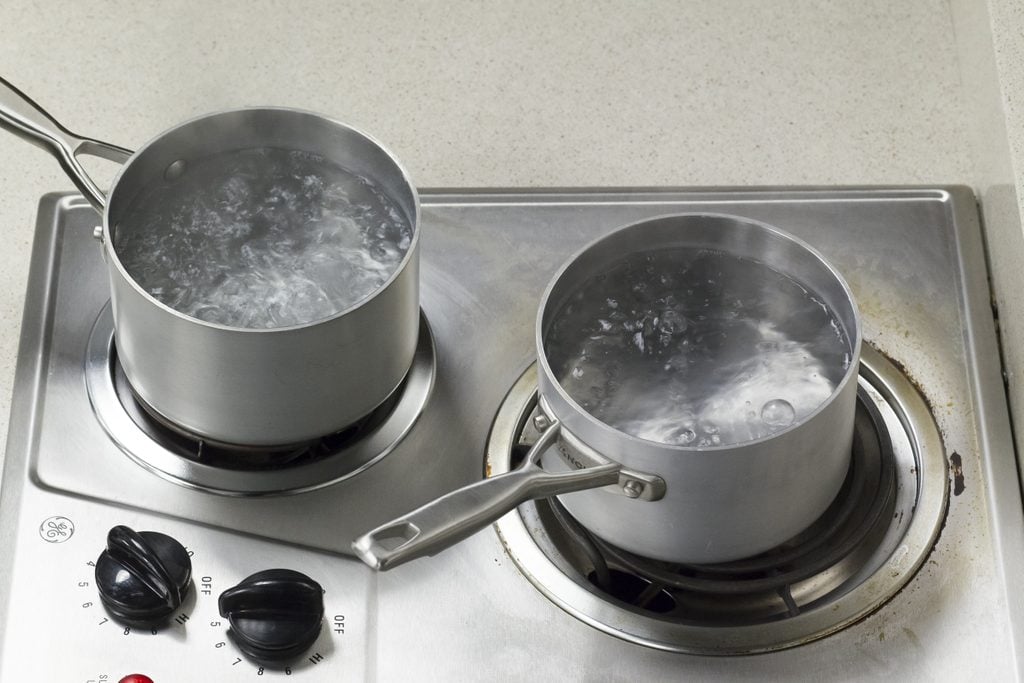
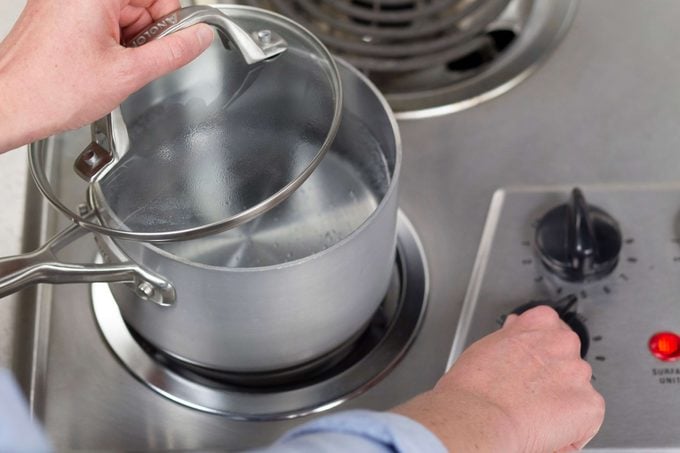 Whether you’re boiling or simmering, you’ve got to start with water. Our Test Kitchen recommends starting with cold tap water (hot water can carry sediments from your water heater which may alter the taste slightly). Fill up your pot, place it over high heat and cover. The lid will trap all the steam and heat inside, helping your water to come up to temperature faster.
Whether you’re boiling or simmering, you’ve got to start with water. Our Test Kitchen recommends starting with cold tap water (hot water can carry sediments from your water heater which may alter the taste slightly). Fill up your pot, place it over high heat and cover. The lid will trap all the steam and heat inside, helping your water to come up to temperature faster. No matter what you’re shooting for, bring your water up to a full, rolling boil. This means that the water is bubbling like crazy (you should be able to hear it) and is producing a lot of steam.
No matter what you’re shooting for, bring your water up to a full, rolling boil. This means that the water is bubbling like crazy (you should be able to hear it) and is producing a lot of steam.

